Physical Address
304 North Cardinal St.
Dorchester Center, MA 02124
Children have special needs and unique disease processes, and thus the diagnostic imaging approaches are also different. Pediatric imaging should be problem oriented. Communication between the referring physician and the pediatric radiologist is encouraged. The essential components of a pediatric imaging facility are listed in Box 25.1 .
Communication and consultation between practitioners and radiologists
Patient and parent preparation
Child-friendly atmosphere
Safe patient immobilization and sedation
Radiation protection
Age-appropriate imaging techniques
Children have special needs and different disease processes, and thus the diagnostic imaging approaches are also different. Pediatric imaging should be problem oriented. Communication between the referring physician and the pediatric radiologist is encouraged ( eBox 25.1 ). The essential components of a pediatric imaging facility are listed in Box 25.1 .
Formulate a diagnostic question based on patient history, physical findings, and appropriate laboratory data
Determine in consultation with a pediatric radiologist which imaging study or studies will most effectively answer the diagnostic question
Weigh potential benefits of imaging procedures against risks and expenses
Inform the pediatric radiologist of all clinical and historical information relevant to diagnosis and patient safety
Prepare patients and parents adequately for radiologic examinations, both physically and emotionally
Obtain results of imaging studies and address abnormal findings
Provide feedback to the radiologist regarding diagnosis and outcome
Pediatric diagnostic imaging can be achieved by various modalities ( Table 25.1 ). X-rays are used in conventional radiography, computed radiography, fluoroscopy, angiography, and CT. Gamma rays are used in nuclear scintigraphy and PET. Ultrasonography uses inaudible sound waves ranging in frequency from 1 to 20 MHz to produce images, whereas magnetic resonance images are generated with a strong magnetic field and radiofrequency (RF) pulse. In the current age, picture archiving and communication systems (PACS) are used. PACS eliminates the use of films, permits rapid retrieval of images and remote viewing, and compacts storage.
| Modality | Advantages | Disadvantages |
|---|---|---|
| X-ray film | Fast; relatively inexpensive; available | Uses radiation; poor soft tissue contrast; two-dimensional imaging only |
| Fluoroscopy | Real-time imaging; relatively inexpensive; available; useful in operating room; can be portable | Uses radiation; no cross-sectional imaging |
| CT | Readily available; excellent delineation of bones, soft tissues, and calcification; multiplanar and 3D reconstruction; minimally invasive (CTA); assists in interventions | Intermediate to high radiation dose; relatively expensive; IV contrast side effects (nephrotoxicity and anaphylaxis); weight limit |
| MRI | Excellent soft tissue characterization; no ionizing radiation; multiplanar imaging; minimally invasive (MRA); functional imaging; assists in interventions | Less readily available; expensive; claustrophobia often a problem; lengthy exams; limited use in unstable patients; may need sedation/GA; metal artifact; contraindicated with cardiac pacemakers and some devices; gadolinium-induced NSF in patients with renal impairment; weight limit |
| Ultrasound | Portable; inexpensive machine; real time; least expensive cross-sectional imaging modality; no radiation; differentiates cystic versus solid masses; multiplanar imaging; Doppler evaluation of blood flow; assists in interventional procedures | Difficult with obese and immobile patients; highly operator dependent; bone and gas obscure anatomy |
| Nuclear medicine | Readily available; functional/molecular imaging | Intermediate to high radiation dose; weak anatomic analysis; may need sedation; radioactive urine and body fluids; expensive |
A few simple techniques can help create a positive imaging experience for the child. Distraction in the waiting room may be beneficial for children of all ages and can be achieved with posters, pictures, and toys. Effective distraction for toddlers includes interactive toys, pinwheels, blowing bubbles, and singing. School-age children enjoy blowing bubbles, TV/video games, books, counting, and deep breathing. Teenagers may prefer deep breathing, stress balls, TV/video games, books, and music.
The well-trained imaging staff can relieve the patient’s apprehension and decrease time and effort to obtain the optimal examination. Technologists should have a gentle demeanor and wear child-friendly, cheerful uniforms.
Child life specialists are specially trained to help children prepare for health care experiences and enable them to cope with imaging or invasive procedures. If aspects of a procedure are painful or uncomfortable, any child older than age 2 is prepared in advance with truthful information, using words that can be understood. The child life specialist is especially useful in some situations, such as (1) a child whose injuries have resulted from suspected child abuse; (2) a child admitted with accidental injuries (e.g., a motor vehicle accident); (3) a child newly diagnosed with chronic illness; (4) a child who recently experienced traumatic loss; (5) a child who exhibits oppositional behavior or has developmental delay; (6) a child having difficulty coping with a necessary procedure, that is, crying, fighting, or hiding; and (7) a child who needs preparation for an invasive procedure.
The imaging room’s environment is modified to reduce a child’s anxiety. Smaller equipment can be hidden or concealed with covers and images. Large equipment such as CT scanners can be decorated to give a sense of adventure ( Fig. 25.1 ) and allow study acquisition without sedation. Other distraction techniques include lamps placed in the line of vision of the patient and displaying entertaining images on the ceiling ( Fig. 25.2 ) or the release of piquant aromas in the imaging room (e.g., coconut). Electronic tablets are often used to play music or games as a distraction during many imaging studies. Movie goggles allow the child to watch a favorite movie while undergoing MRI or a nuclear medicine scan.
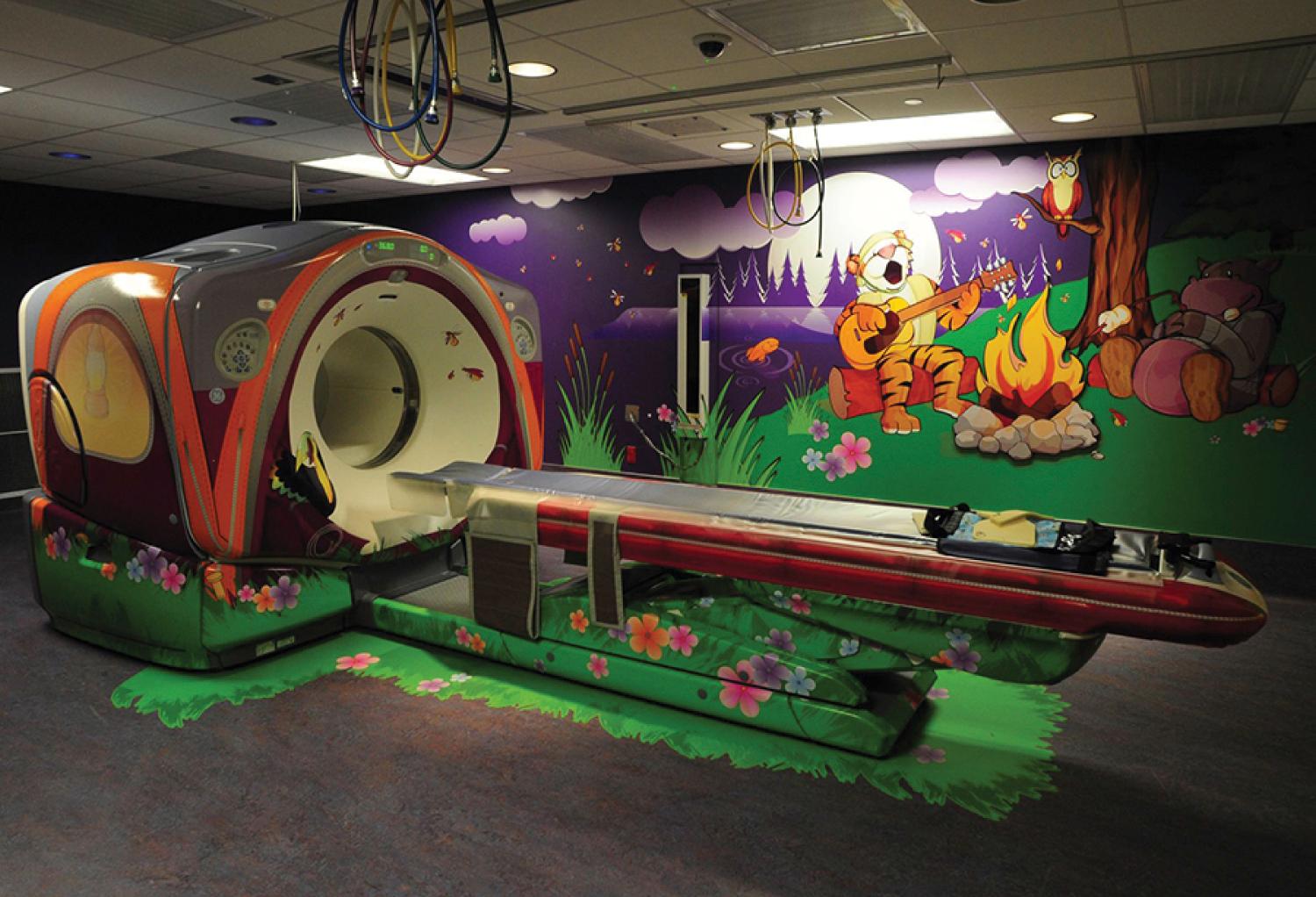
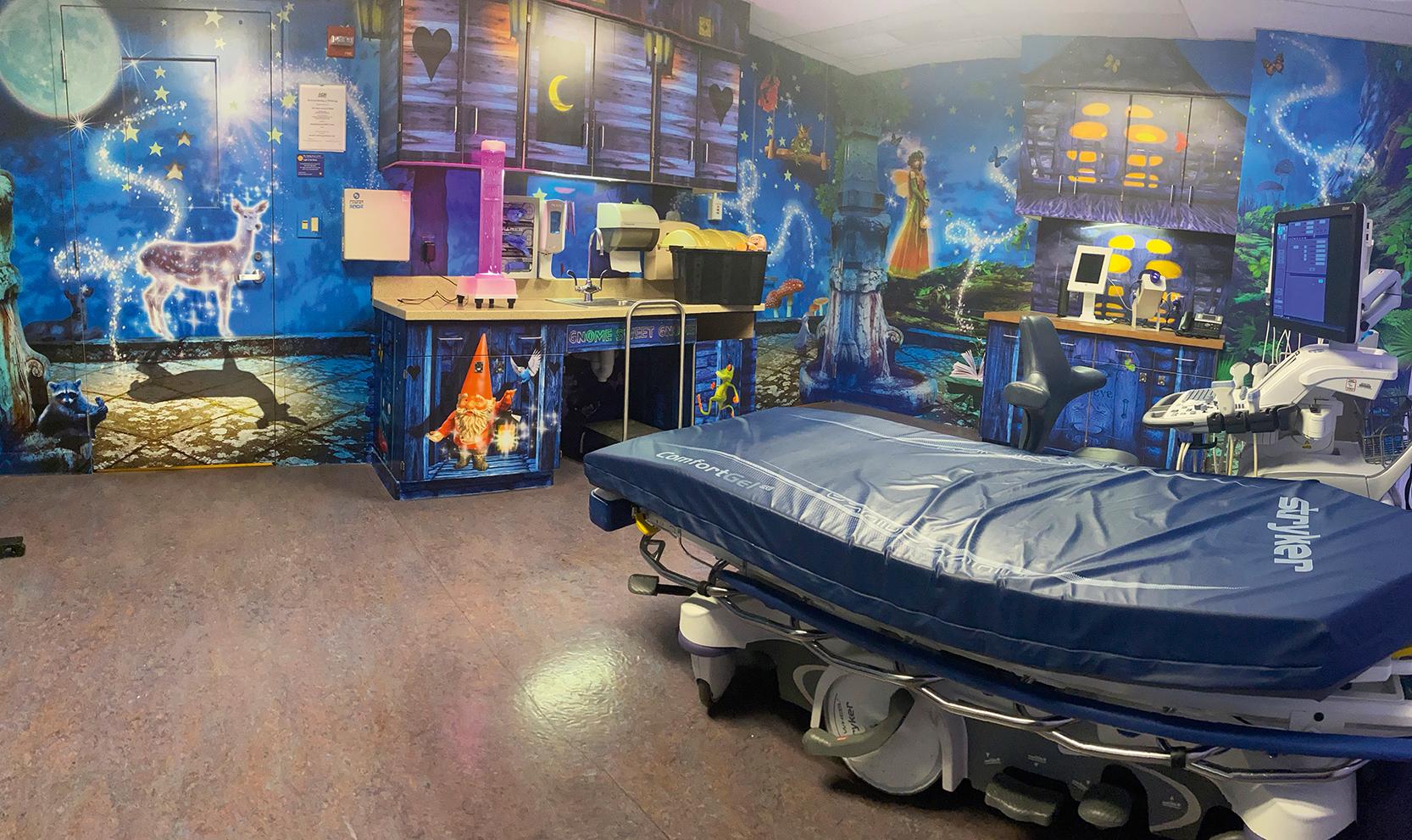
The technologist usually allows parents to be present in the examining rooms and even to assist with some studies. This decreases the repeat image rate and so decreases the radiation dose to the child. When a child lies supine, he or she may feel vulnerable. Comfort positions can give children a sense of control and help them feel more relaxed, that is, sitting on a chair or in a parent’s lap, handholding with a parent, or hugging. The child is encouraged to participate in producing the best possible examination by being permitted to make individual choices (e.g., placement of a toy or blanket, the position of a parent, the flavor of oral contrast material, or the selection of a bandage).
The radiology team should always remember to use simple language for child-friendly explanations. For children of any age, the wrong choice of words can have a negative impact and potentially long-lasting effects. Avoid saying “dye/contrast”; say instead, “a drink/sticky water that helps the doctor see the inside of your belly clearer in your pictures.” Also, describe the imaging room environment in ways that can be related to the child’s home, for example, the noise of a CT scanner can be described to be like that of a “washing machine,” or a urinary catheter can be described as a “tiny straw that takes out pee-pee and puts in the x-ray water.” Young children have little sense of time; the radiology team should always prepare them to know when they will be done with their examination. For example, if a child is undergoing a voiding cystourethrogram (VCUG), avoid saying, “this will only take 15 minutes”; instead, say “you’ll be all finished and can get up after you potty on the table for us.”
Effective dose is expressed as an SI unit, the millisievert (mSv) ( Table 25.2 ). A major benefit of the effective dose is that it permits all radiologic examinations that use ionizing radiation to be directly compared, using a simple common scale. Note that the effective radiation dose of one adult chest radiograph (0.1 mSv) is comparable to natural background radiation for 10 days (background radiation is 3 mSv/year in the United States; people living in Colorado or New Mexico receive about 1.5 mSv more per year than those living near sea level, that is, 4 to 5 mSv/year).
| Imaging Area | Effective Dose (mSv) | Equivalent Number of Chest X-Rays |
|---|---|---|
| Three-view ankle | 0.0015 | 1/14th |
| Two-view chest | 0.02 | 1 |
| Anteroposterior and lateral abdomen | 0.05 | 2½ |
| Technetium-99m radionuclide cystogram | 0.18 | 9 |
| Technetium-99m radionuclide bone scan | 6.2 | 310 |
| 18 F-FDG PET scan | 15.3 | 765 |
| Fluoroscopic cystogram | 0.33 | 16 |
| Head CT | 4 | 200 |
| Chest CT | 3 | 150 |
| Abdomen CT | 5 | 250 |
The radiologist as “consultant” can triage imaging examinations to eliminate inappropriate referrals or encourage alternative procedures with less or no ionizing radiation. Imaging protocols must be as evidence-based as possible and the American College of Radiology (ACR) and the Society for Pediatric Radiology (SPR) guidelines should be implemented.
Americans were exposed to more than seven times as much ionizing radiation from diagnostic medical procedures in 2006 than they were in the early 1980s. The increase over the past quarter century puts the cumulative national medical exposures on a level with natural background radiation exposure ( Fig. 25.3 ). The estimated cumulative individual dose from all sources in the early 1980s was 3.6 mSv and in 2006 was 6.2 mSv, almost double the previously reported value. The increase in medical exposure was the only significant change in the two estimates. The largest part of the increase in medical exposure was from CT scans, amounting to almost one half of the imaging exposure, and nuclear cardiac scans, amounting to one fourth of the current total ( Fig. 25.4 ). In 2006 alone, more than 63 million CT scans were performed in the United States. Approximately 7 million CT scans were obtained in children in 2007. Children are at increased risk from radiation because of their greater sensitivity to radiation and a longer lifetime to manifest those changes. To be safe, we should act as if low doses of radiation cause harm using the as low as reasonably achievable (ALARA) principle routinely.
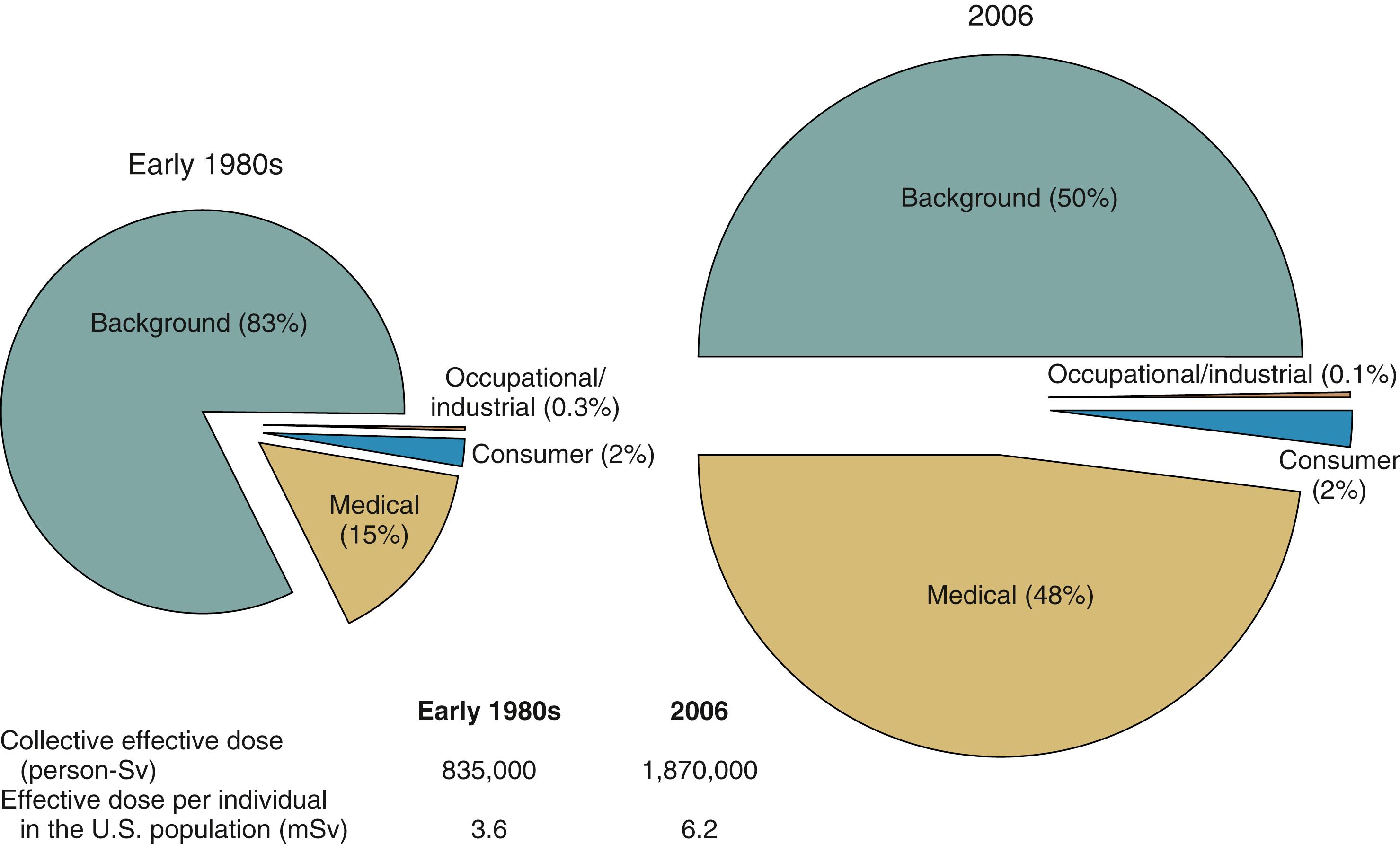
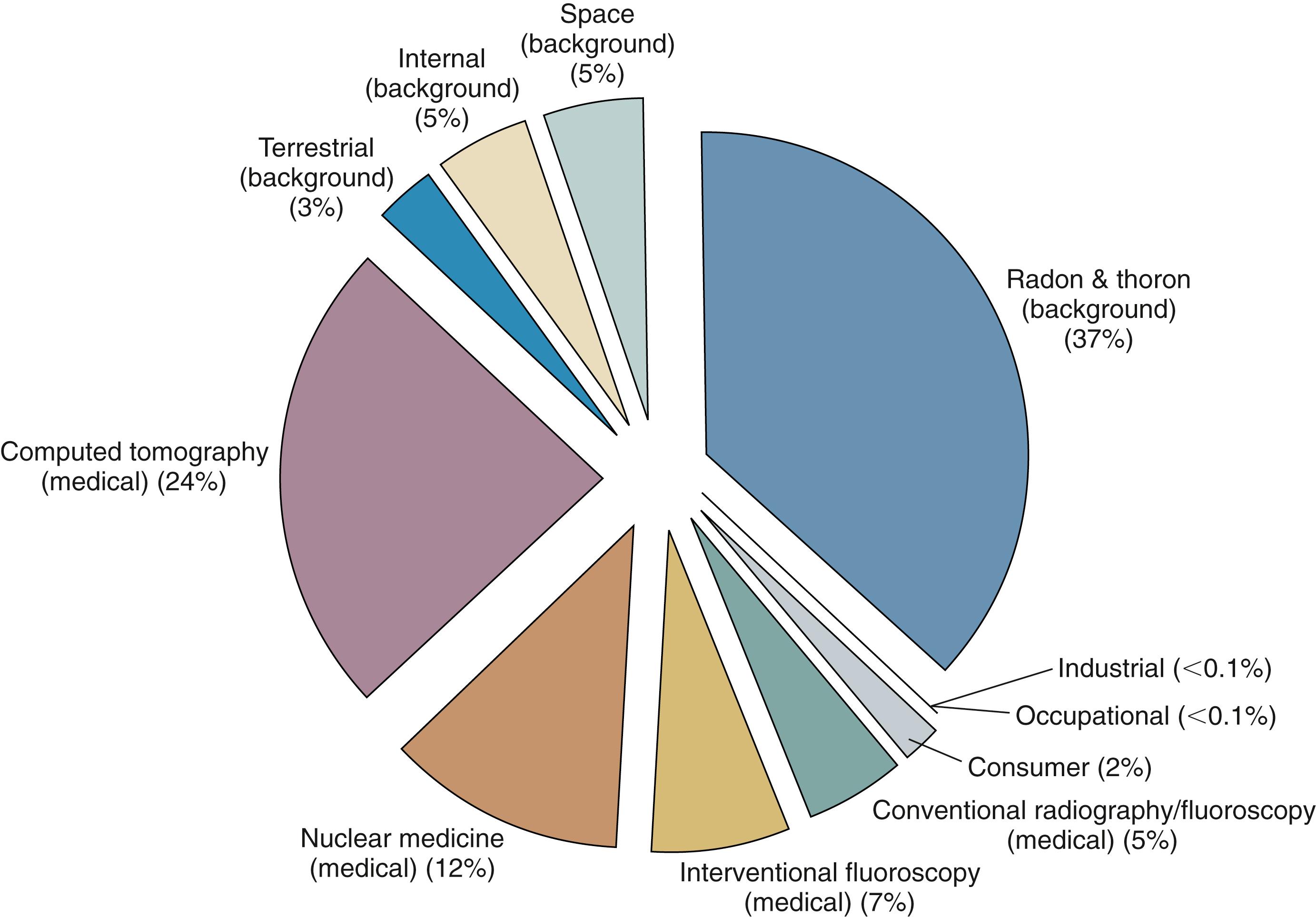
The exact radiation risk in CT examinations, and even whether a risk absolutely exists, are controversial topics. However, most scientific and medical organizations support the concept of the linear, no-threshold model for ionizing radiation risk of cancer induction, and believe that radiation even at low levels (doses below 100 mSv) may have a harmful effect. This assumption, however, overlooks cellular repair mechanisms. Some researchers estimate the increased risk that a young child might develop cancer related to an abdominal CT scan is in the magnitude of 1:4000. This is based on the most widely used estimate of risk of cancer from ionizing radiation at 5% per sievert (Sv), and diagnostic imaging doses are in the millisievert (mSv) range (5 mSv for abdominal CT). One should also note that the background lifetime risk of fatal cancer is 20% to 25% (1 in 4 or 5). The benefits of CT are real and known, and the risks are tiny and unknown.
Conservative estimations of potential risk (i.e., any required assumptions are made toward the direction of overestimating risk rather than underestimating it) show that the potential risk of dying from undergoing a CT examination is less than that of drowning or of a pedestrian dying from being struck by any form of ground transportation, both of which most Americans consider to be extremely unlikely events ( eTable 25.1 ); this provides a comparison of the statistical odds of dying from an abdominopelvic CT examination relative to other causes of death. It can be seen that the lifetime risk of a fatal cancer from all causes is 22.8%, and the lifetime potential risk of a fatal cancer from the radiation associated with a body CT examination is approximately 0.05%.
| Cause of Death | Estimated Number of Deaths Per 1000 Individuals |
|---|---|
| Cancer | 228 |
| Motor vehicle accident | 11.9 |
| Radon in home | |
|
3 |
|
21 |
| Arsenic in drinking water | |
|
1 |
|
13 |
| Radiation-induced fatal cancer | |
|
0.5 |
| Annual dose limit for a radiation worker | |
|
0.5 |
|
2.5 |
| Pedestrian accident | 1.6 |
| Drowning | 0.9 |
| Bicycling | 0.2 |
| Lightning strike | 0.013 |
The ordering physician needs to ensure that a CT scan is justified, and the radiologist needs to optimize how the scan is performed. Because children are smaller than adults and need less radiation to create the same signal-to-noise ratios, the tube current (milliamperes [mA]) can be greatly reduced when imaging a small child. Other techniques include reducing the kilovoltage peak (kVp); using in-plane shielding for areas such as the eye, thyroid, and breasts; increasing beam pitch; and picking a CT manufacturer that has put effort into dose-reducing technology (e.g., adaptive statistical iterative reconstruction [ASIR]) ( Fig. 25.5 ).

The Alliance for Radiation Safety in Pediatric Imaging has created resources to address the relative risk of CT for children, including parent information pamphlets and a convenient medical imaging record card, similar to the familiar immunization card, for parents to track their child’s imaging history. This card may be distributed by pediatricians or downloaded by parents from the Image Gently website ( eFig. 25.1 ). This card alerts families and their doctors to the frequency of patient imaging examinations. With relocation of families and the use of different hospital centers in the same community, this card may help decrease the number of repeat examinations performed.
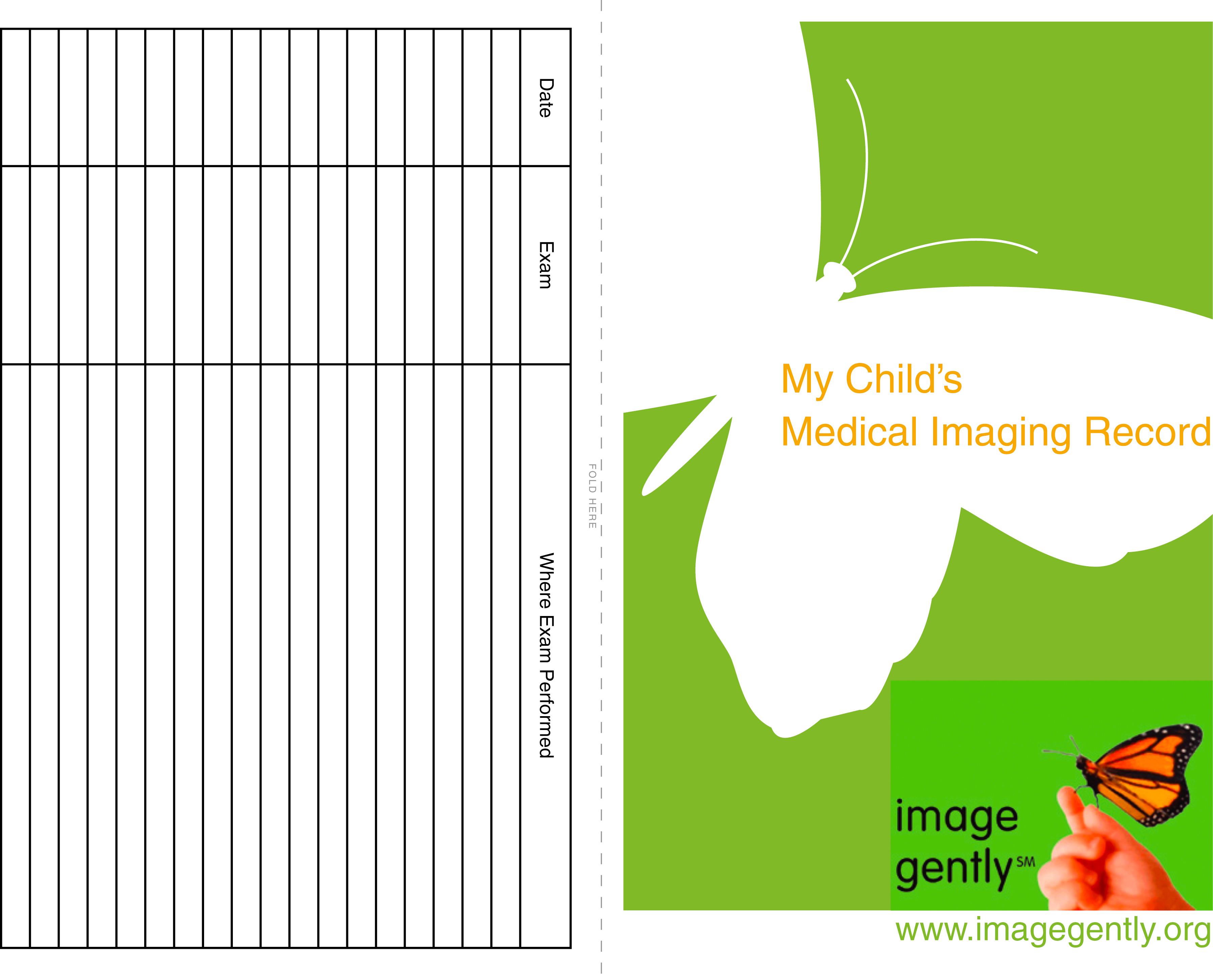
The advantages of radiography in pediatric imaging include the following:
Fast
Relatively inexpensive
Widely available
No need for sedation
Portable
Plain films of the chest and skeletal system are important (about 50% of all pediatric imaging consists of chest radiographs)
The disadvantages of radiography in pediatric imaging include the following:
Uses ionizing radiation
Poor soft tissue contrast
Two-dimensional imaging only
X-rays are a form of short electromagnetic radiation produced by energy conversion when fast-moving electrons from the cathode filament of the x-ray tube interact with the tungsten anode (target) ( Fig. 25.6 ). The amplitude of the tube current (expressed as milliamperes [mA]) depends on the emission rate of electrons from the cathode, which is determined by the cathode temperature. The speed of the electrons as they are propelled from the cathode to the anode is determined by the x-ray tube potential (kilovoltage peak [kVp]). When an x-ray beam is directed toward the examined part of the body with an imaging cassette on the other side, an image is formed. The resultant image is a recording of internal body structures in which the black areas represent the least dense body structures that have allowed the x-rays to pass through (i.e., lungs) and the denser structures (i.e., bone), which have absorbed the x-rays, appear white ( eFig. 25.2 ).
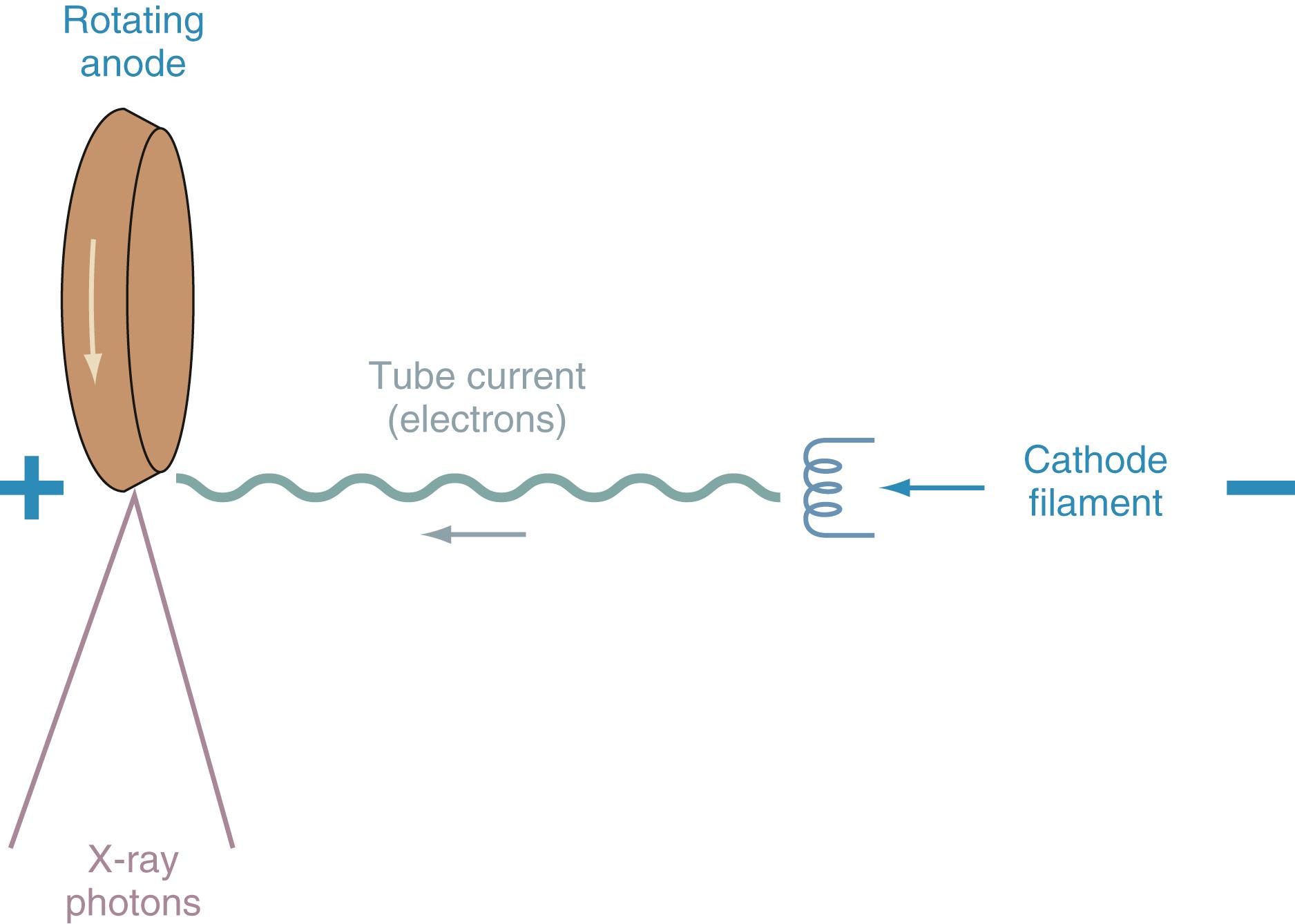
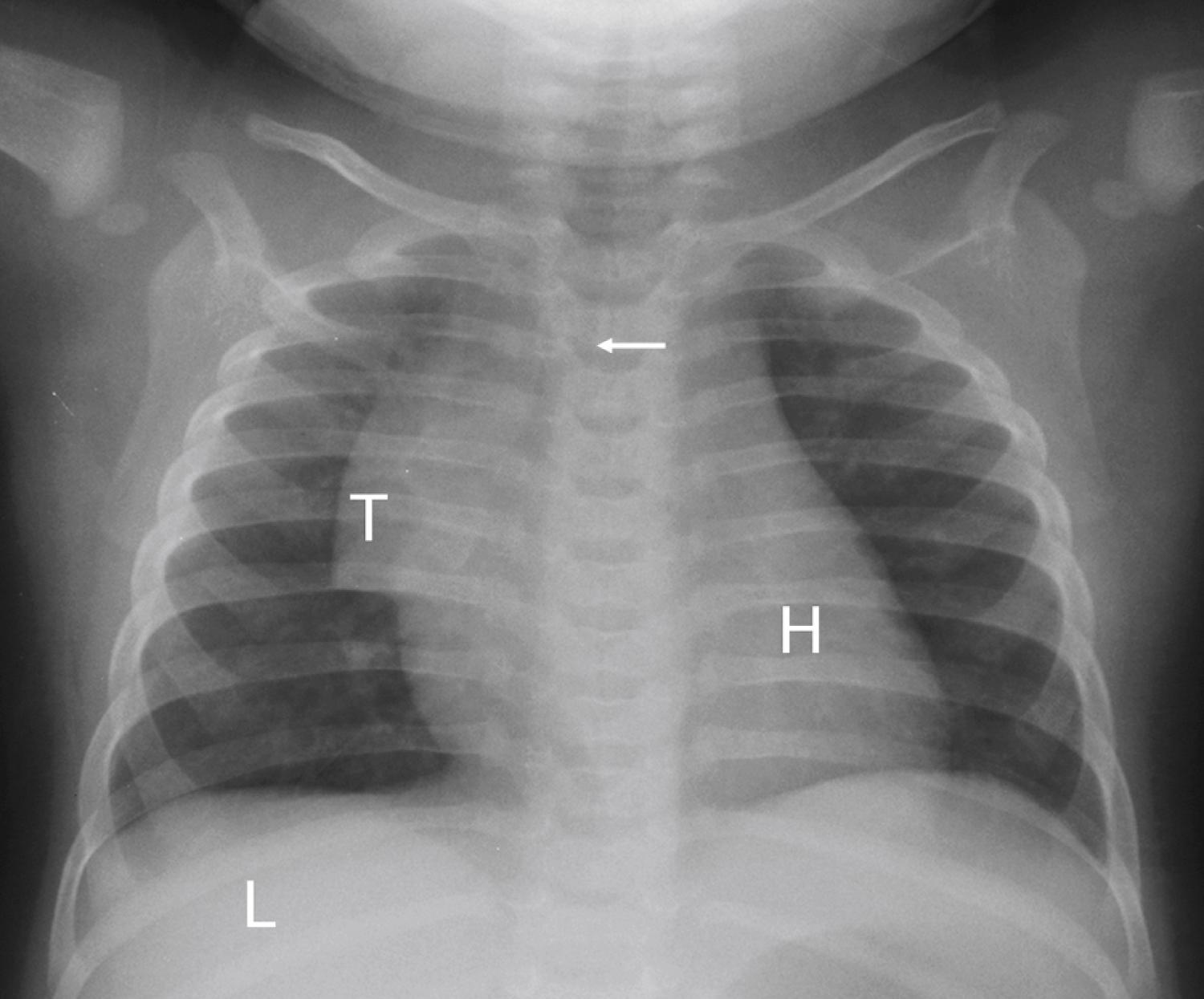
Computed radiography has replaced conventional film-based radiography. The acquired image is displayed instantly on the high-resolution monitor of the PACS. eTable 25.2 lists common indications for plain radiography.
| Organ System | Indications |
|---|---|
| Head and neck | Craniosynostosis Sinusitis Adenoid hypertrophy |
| Chest | Acute or chronic lung disease Air trapping or atelectasis Congenital or acquired heart disease Hydro- or pneumothorax Pneumomediastinum Pulmonary, hilar, mediastinal, or chest wall mass Endotracheal tube or vascular catheter placement |
| Abdomen | Abdominal pain or mass Bowel obstruction, ileus, or constipation Necrotizing enterocolitis Pneumoperitoneum Renal or biliary stone disease Enteral tube or vascular catheter placement |
| Musculoskeletal system | Trauma Mass Infection Inflammatory, vascular, or metabolic disease Congenital and developmental anomalies (e.g., skeletal dysplasia, scoliosis, hip dysplasia, tarsal coalition, clubfoot) Bone age determination |
| Miscellaneous | Ventriculoperitoneal shunt assessment Foreign body localization |
The anteroposterior and lateral views of the neck are useful in assessing the trachea, pharynx, retropharynx, epiglottis, tonsils, adenoids, and bony skeleton. Stridor is one of the most common indications for imaging the neck. Other indications include snoring, hoarseness, abnormal cry, neck mass, suspected foreign body, epistaxis, trauma, and caustic ingestion.
The retropharyngeal soft tissues extend from the adenoids, which are visible by 3 to 6 months of age, to the origin of the esophagus at the level of C4 to C5. A useful ratio is the width of the retropharyngeal soft tissue to that of the C2 vertebral body. The ratio varies in inspiration from almost 1.0 before 1 year old to 0.5 by 6 years old. The soft tissue width should not exceed 50% of the accompanying vertebral body to C4 ( Fig. 25.7 ). Expiratory tracheal buckling can create bulging of the trachea anteriorly, causing an apparent increase in retropharyngeal soft tissues and creating a “pseudo-retropharyngeal abscess” ( Fig. 25.8 ). Pseudo-retropharyngeal abscess can be differentiated from a true abscess when an appropriately positioned inspiratory film demonstrates supraglottic airway and hypopharyngeal distention with air ( Fig. 25.9 ). Appropriate patient positioning is critical. The examination of the lateral view of the soft tissues of the neck must be performed in slight extension and during inspiration ( Fig. 25.10 ). The most common cause of a pseudo-retropharyngeal abscess is a film taken during expiration or swallowing, or with an improperly positioned child.
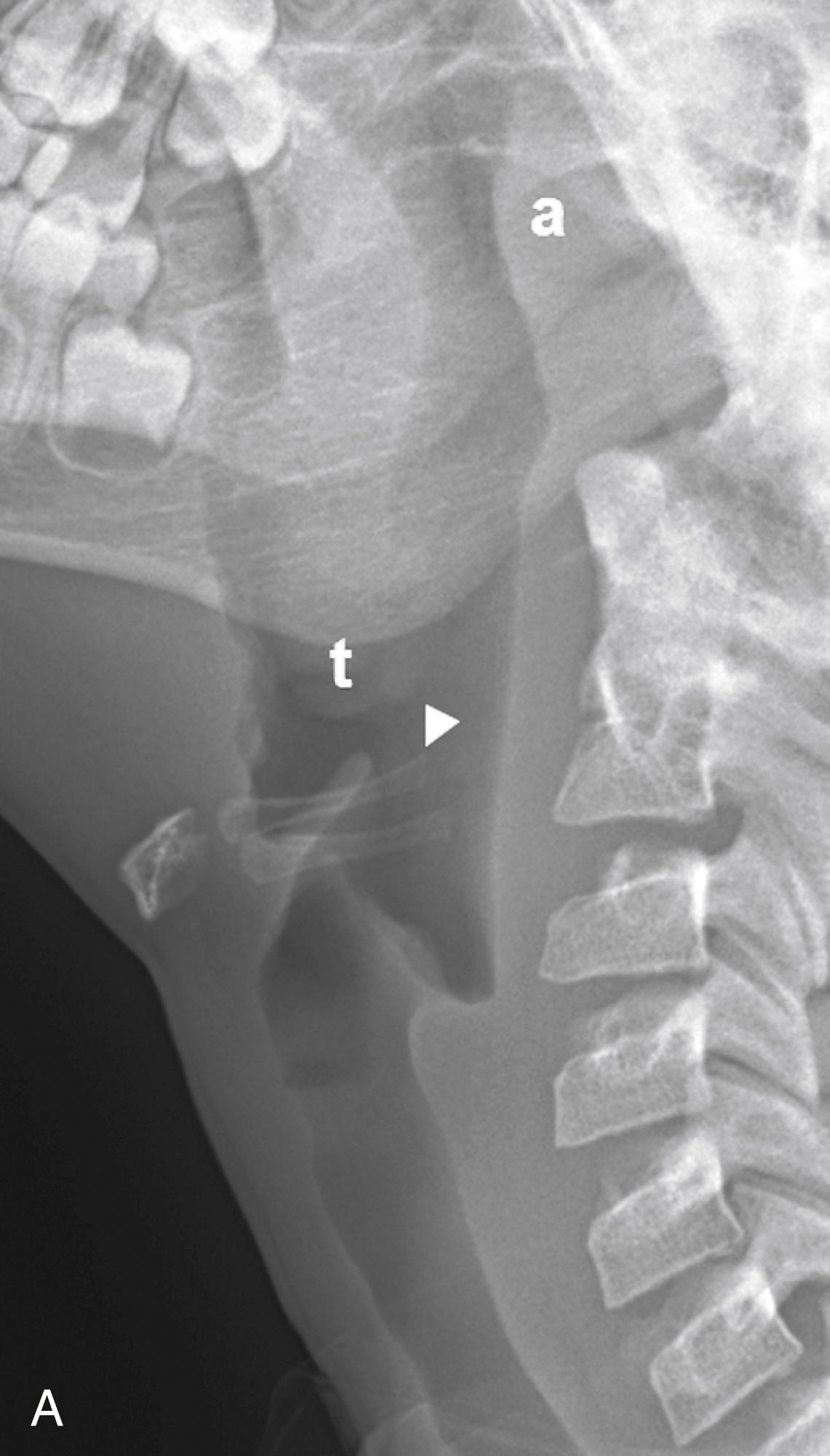
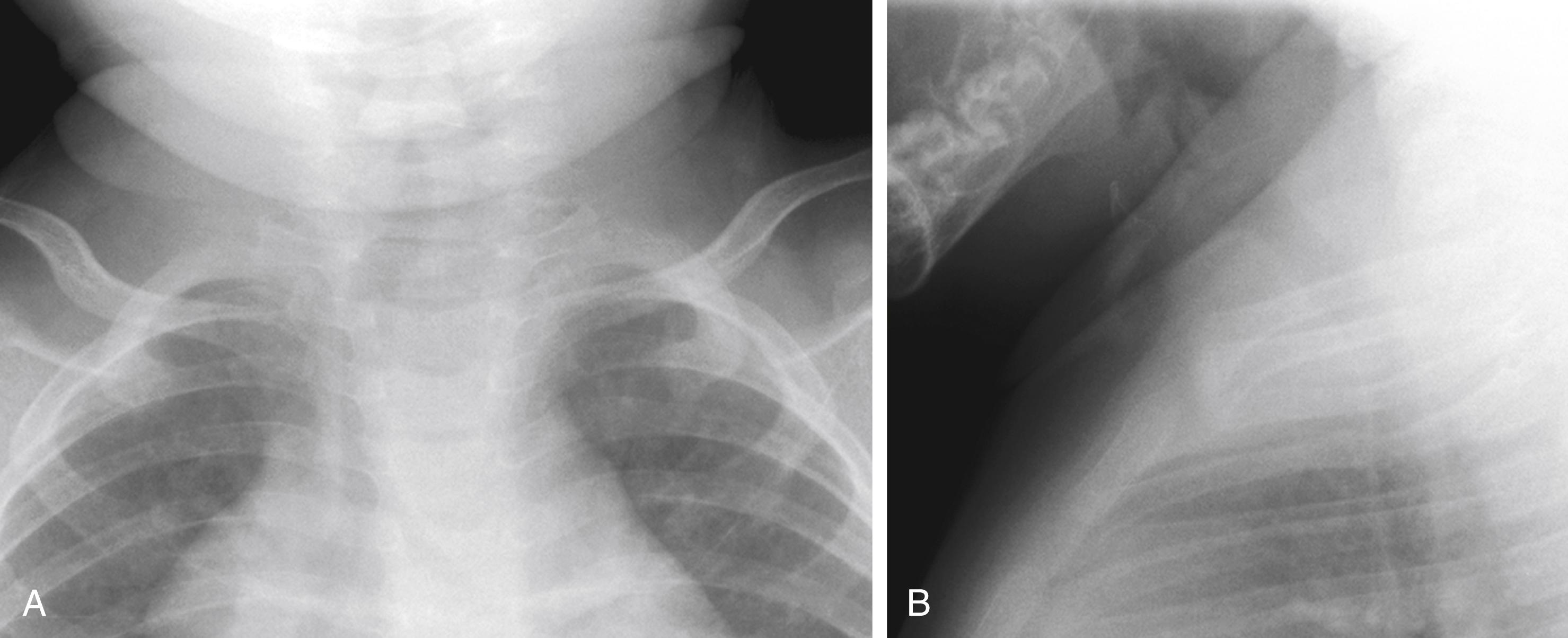
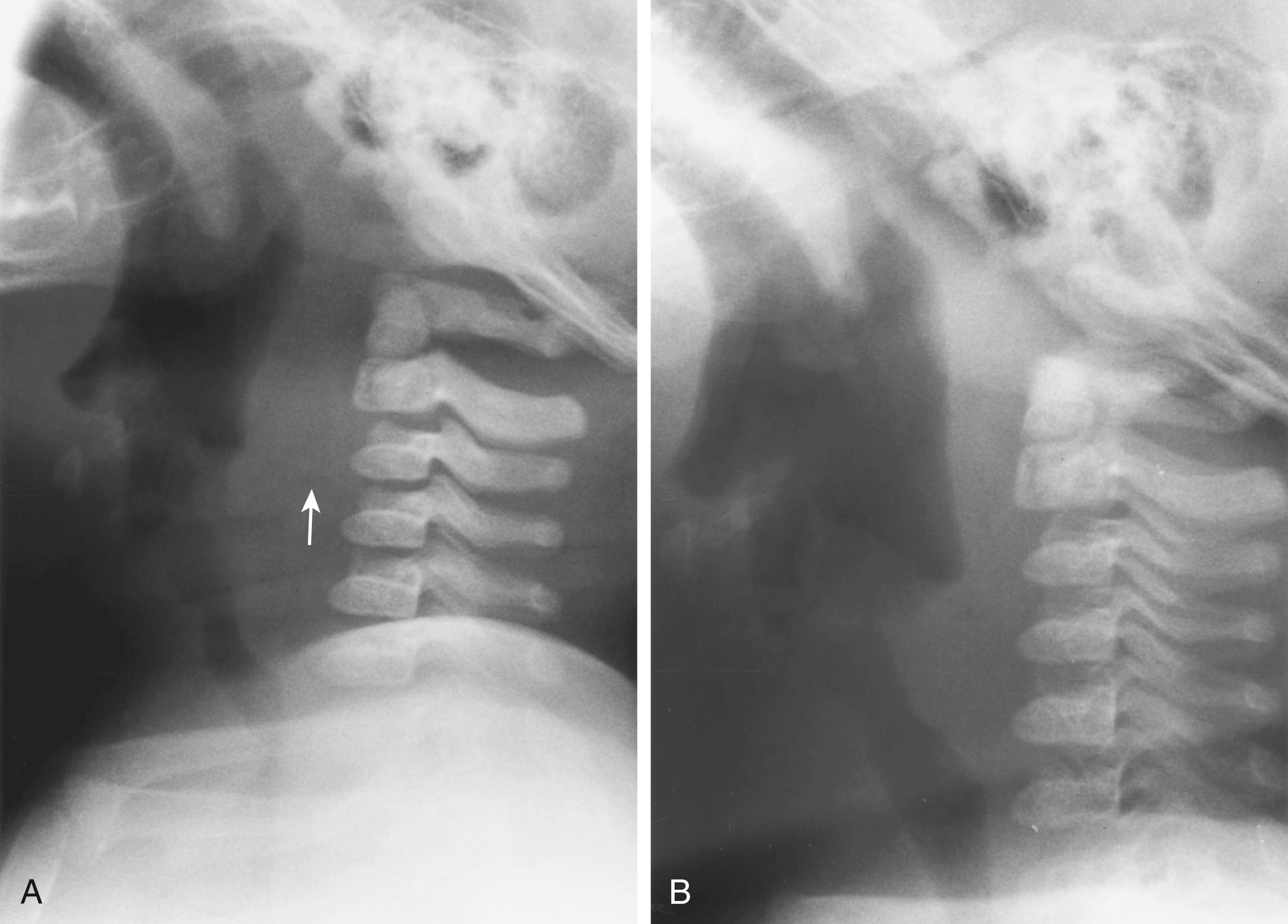
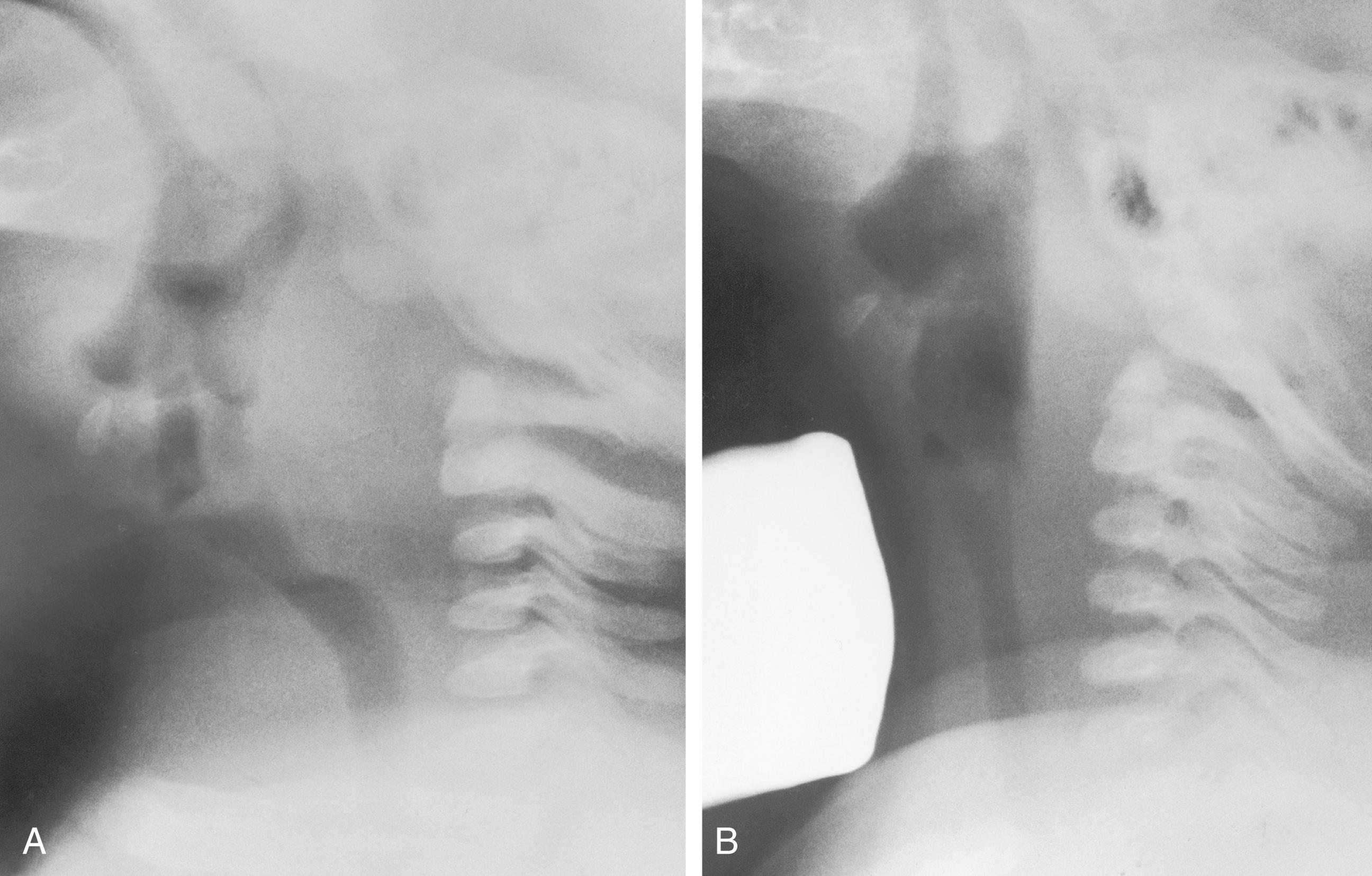
The lateral view of the neck is optimal for evaluating the supraglottic airway (see Fig. 25.7 ). The lower border of the nasopharynx is the hard palate, soft palate, and uvula. The oropharynx (below the hard and soft palate) leads to the air spaces at the base of the tongue, which are the valleculae. Immediately behind the valleculae is the epiglottis. The hyoid bone is inferior and anterior to the valleculae. The oropharynx also merges posteriorly with the nasopharynx to form the hypopharynx. The tonsils are seen in the lateral walls of the hypopharynx. Anteriorly, the hypopharynx leads to the larynx and becomes the esophagus. The pyriform sinuses are the most lateral and inferior margins and provide a landmark for the level of the vocal cords.
The lateral film is important in the assessment of (1) the encroachment of adenoidal tissue on the nasopharyngeal airway; (2) retropharyngeal swelling/abscess (air in the retropharyngeal space); (3) the degree of hypopharyngeal airway distention as a measure for airway encroachment (croup); and (4) identification of a radiopaque foreign body. Calcification in respiratory cartilage, although very rare in children, is pathologic; it is seen in chondrodysplasia punctata and relapsing polychondritis. The hyoid bone may be ossified at birth.
The frontal radiograph is best for evaluation of tracheal position. Normally, the trachea is slightly deviated to the right by the aortic arch (deviation to the left is always abnormal). A normal thymus will not affect the trachea. Expiration causes buckling of the trachea to the right (see Fig. 25.8 ). Note that the airway is a dynamic system and changes in caliber and position so that an isolated, single film may be quite misleading. Nonetheless, an abnormal configuration of the airway should be further evaluated in light of the clinical history.
A systematic approach to the radiographic evaluation is crucial for anyone dealing with children. Comparison with previous imaging studies is mandatory and is facilitated by the use of a PACS. A chest film is always examined for information about the heart and lungs, but should also evaluate the nonpulmonary areas, that is, the abdomen, bones, soft tissues, and airway, to be sure all abnormalities are seen. Only then should one progress to the mediastinum. A good habit to develop is to imagine a circle on the film so as to dispense with all the non-cardiopulmonary areas. Begin at the corners, where the patient information is. Check the name, date, and especially the left and right markers. An easy way to complete the circle is to progress from the name tag to the markers to the ABCS of the film: A, abdomen; B, bones; C, chest (airway, mediastinum, lungs, and diaphragm); and S, soft tissues. Carefully observe the easily missed areas: under the diaphragm, through the heart, paraspinal lines, lung apices, shoulders, and soft tissues of the neck.
On every chest film, read the abdominal portion as you would read an abdominal film. Evaluate the abdomen (regardless of how little of it can be seen) on every chest film, and note whether the stomach bubble is on the left and the liver on the right. Is it an erect film? If so, examine it specifically for calcifications, gallstones, or pancreatic calcification.
Determine the presence of bowel distention, air/fluid levels, and free intraperitoneal air. The heart and liver are semi-transparent organs; one can see opacities or bronchial markings projecting over their shadows. Then look at bones and soft tissues; one can often see portions of the arms, shoulders, ribs, sternum, and mandible, as well as cervical, thoracic, and lumbar vertebrae. Be alert for fractures ( Fig. 25.11 ), congenital abnormalities (e.g., absent clavicles), bone destruction, or other signs of disease. Examine the soft tissues of the neck, thorax, and abdomen to detect any swelling, foreign body, calcifications, and so on. The soft tissues may reveal multiple artifacts, such as hair braids, buttons, bandages, electrocardiogram (ECG) electrodes, or redundant skin folds. Soft tissue swelling or subcutaneous calcifications can be clues to systemic disease.
![Fig. 25.11, Supine chest radiograph of a 3-day-old newborn with surfactant deficiency. A radiologist interpreting this chest film systematically, that is, by examining the ABCS (A, abdomen; B, bones; C, chest [airway, mediastinum, lungs, and diaphragm]; and S, soft tissues), should not miss the fracture involving the right humerus at the edge of the image. Note that the patient is rotated to the left with the heart appearing prominent, likely due to rotation. Fig. 25.11, Supine chest radiograph of a 3-day-old newborn with surfactant deficiency. A radiologist interpreting this chest film systematically, that is, by examining the ABCS (A, abdomen; B, bones; C, chest [airway, mediastinum, lungs, and diaphragm]; and S, soft tissues), should not miss the fracture involving the right humerus at the edge of the image. Note that the patient is rotated to the left with the heart appearing prominent, likely due to rotation.](https://storage.googleapis.com/dl.dentistrykey.com/clinical/FundamentalsofPediatricRadiology/12_3s20B9780323777889000250.jpg)
On an adequate film obtained during deep inspiration, nine posterior ribs and five anterior ribs should be seen above the diaphragm. If the child is too young to cooperate, expose on full inspiration, during normal respiration. Babies’ and toddlers’ breathing is abdominal: watch for an expanded abdomen in the anteroposterior position. The child/baby must not be crying during exposure. If so, inspiration will be too deep, and the overinflated lungs may create a misleading appearance that can be mistaken for pathology. The differences in appearance on inspiration and expiration are more marked than in adults. With a good inspiratory effort on the frontal view, less than one-third of the heart projects below the dome of the diaphragm; the domes of the diaphragm are rounded (if very domed, the film is expiratory). If the child has taken a shallow breath, the heart may appear enlarged; the vessels may coalesce to give a false impression of an opacity, especially in the region of the bases and hila. On the lateral view, obliquely oriented hemidiaphragms are seen in good or possibly increased lung volume (if horizontally oriented, the film is expiratory). The vertebral bodies become blacker as we progress from superior to inferior on the lateral view.
Conventional radiographs of the chest are frequently produced with a portable machine and with the younger patient (younger than 2 years old) placed supine. Upright films can be obtained after age 2; until 3 or 4 years old the patient is usually sitting for an anteroposterior projection. Children 5 years old and older can stand for a posteroanterior projection. Proper immobilization and positioning are mandatory. For radiation protection purposes, the primary beam must be collimated within the area of the cassette, and pediatric lead rubber aprons, obtainable in several sizes, should be used for gonadal protection, but excluded from the area of the cassette. It should be noted that there is new evidence that gonadal shielding for pelvis imaging actually increases total radiation dose and gonadal radiosensitivity is lower than previously thought. Frontal views are often the only ones necessary, but lateral views can be obtained as indicated.
When the x-ray passes through the patient from back to front (a posteroanterior projection), the heart is closer to the film and is less magnified. Conversely, if the x-ray beam enters the front of the patient’s chest, passes through the back and onto the film (an anteroposterior projection), the magnified heart and great vessels may give the impression of cardiomegaly. This is a common problem with portable chest films, which are taken in the anteroposterior projection. Also, the closer the tube to the film, the more the magnification. Routinely, portable films are exposed 40 inches (1 m) from the tube, adding to the magnification. This is compared to 6 feet (1.8 m) used in the erect patient, which causes less magnification.
When the patient is supine, the vascular supply to the upper and lower lobes of the lungs is equal because gravity has no effect. When sitting or standing, gravity plays a significant role, and the upper lobe vessels are less distended than the lower lobe vessels and consequently smaller (one-third to two-thirds size). One can determine that a film was produced with the patient in the erect position by looking at the air/fluid level in the stomach and by comparing the relative sizes of the upper and lower pulmonary vasculature.
If the patient is well centered on the frontal view, (1) the medial aspects of the clavicles are symmetrical in relation to the midline, (2) the anterior ribs are equidistant from ipsilateral pedicles, (3) the position of the carina approximates the right pedicles, and (4) the two lungs are symmetrical in density. The signs of rotation include asymmetrical clavicles, a difference in lung aeration, heart projected over one hemithorax and not the other, and asymmetrical ribs when relating the anterior rib to the pedicles (see Fig. 25.11 ). On the lateral view, the ribs are not seen posteriorly in the straight (unrotated) patient. If the patient is slightly rotated, the ribs are shown on each side posterior to the spine.
Adequacy of exposure can be assessed on the frontal film by examining the vertebral column behind the heart. The exposure is correct when we can see (1) the detailed spine and pedicles behind the heart, and (2) the pulmonary vessels in the peripheral lung. If we can see only the spine but not the pulmonary vessels, the film is too dark (overexposed).
The mediastinum is composed of the thymus, trachea, heart, great vessels, esophagus, lymph nodes, and neural elements. The mediastinum is divided on the lateral radiograph into (1) the anterior portion, including the space in front of the heart and great vessels; (2) the middle portion, that is, the space between the anterior and posterior mediastinal components, including the heart, airway, esophagus, and lymph nodes; and (3) the posterior portion, including everything behind a line connecting the midportion aspects of the vertebrae, including the vertebrae, neural elements, and paraspinal lymph tissue. In some classifications, the posterior mediastinum begins with the anterior aspect of the vertebral body.
The thymus may make interpreting pediatric chest radiographs difficult. It can simulate cardiac enlargement, lobar collapse, pulmonary infiltrates, and mediastinal masses. The thymus constitutes the major portion of the mediastinal silhouette in a normal newborn. It may extend from the lung apex to the diaphragmatic surfaces; be insinuated into the minor fissure on the right, giving a “sail sign” (see eFig. 25.2 ); and may be bilaterally symmetrical or predominantly one-sided ( Fig. 25.12 ). The normal thymus is a “soft” organ situated in the anterior mediastinum and never “pushes” on the airway or any other intrathoracic structure. The thymus appears smaller as the child becomes older, but the thymus weighs the most in adolescents. It is prominent in some children until 4 to 5 years old, and may persist beyond 5 years, confounding interpretation. Thymic remnants can remain in adults and will be gradually replaced by fat. In an unwell child, the thymus can decrease in size and is often not seen. The contour of the thymus is “wavy,” because it insinuates itself between the anterior ribs ( Fig. 25.13 ; see Fig. 25.12 ).
![Fig. 25.12, Coronal magnetic resonance imaging (MRI) of the chest (short tau inversion recovery [STIR] sequence) demonstrates a left-sided normal thymus in a 7-month-old infant. An anterior cut shows the “wavy thymus sign” (arrows) as the thymus insinuates itself between the anterior ribs (r) . Fig. 25.12, Coronal magnetic resonance imaging (MRI) of the chest (short tau inversion recovery [STIR] sequence) demonstrates a left-sided normal thymus in a 7-month-old infant. An anterior cut shows the “wavy thymus sign” (arrows) as the thymus insinuates itself between the anterior ribs (r) .](https://storage.googleapis.com/dl.dentistrykey.com/clinical/FundamentalsofPediatricRadiology/13_3s20B9780323777889000250.jpg)
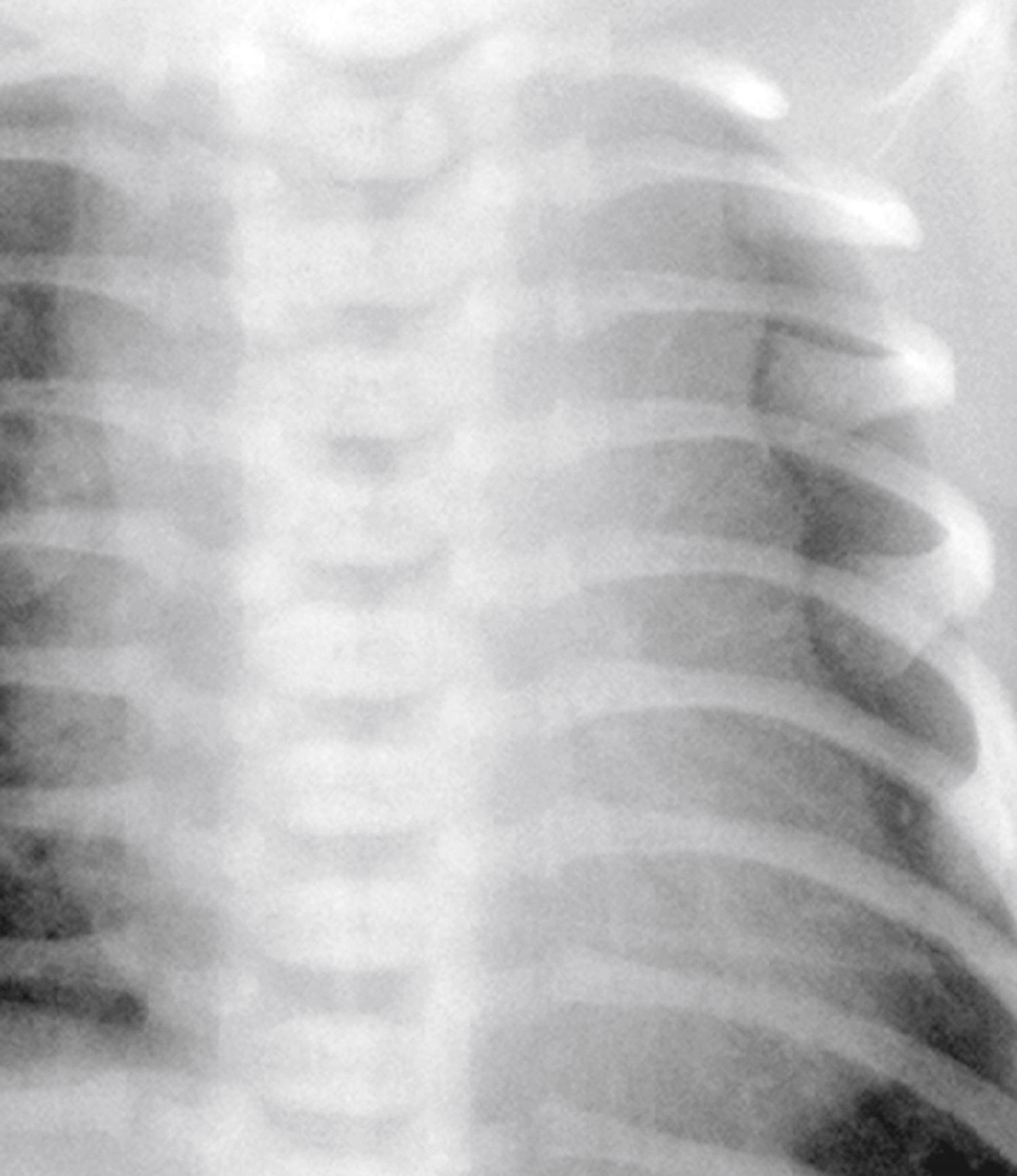
The shape of the heart on plain radiographs changes with the patient’s age. The heart in younger individuals appears more globular in shape, making analysis of specific chamber abnormality difficult. The newborn right heart chambers are larger than the left, and before closure of the patent ductus arteriosus, right-sided cardiac output is greater than left-sided output. This makes identification of the aortic arch difficult or impossible. The right atrial contour in the frontal view and the right ventricular contour in the lateral view will appear abnormally enlarged in these patients. Furthermore, the transverse diameter of the heart is increased, thus increasing the normal cardiothoracic ratio. The thymic shadow regresses by the end of the first year of life, and the heart appears to rotate and descend into the chest. The typical “normal” appearance of the heart does not begin to become apparent until 6 to 8 years of life. However, through adolescence, the apparent size of the main pulmonary artery segment remains increased. Through the teens and early twenties, the size of the main pulmonary artery and base of heart continue to decrease, and the size of the aortic arch increases in caliber, so that by the mid-twenties, the appearance of a “normal” heart may be characterized ( Fig. 25.14 ).
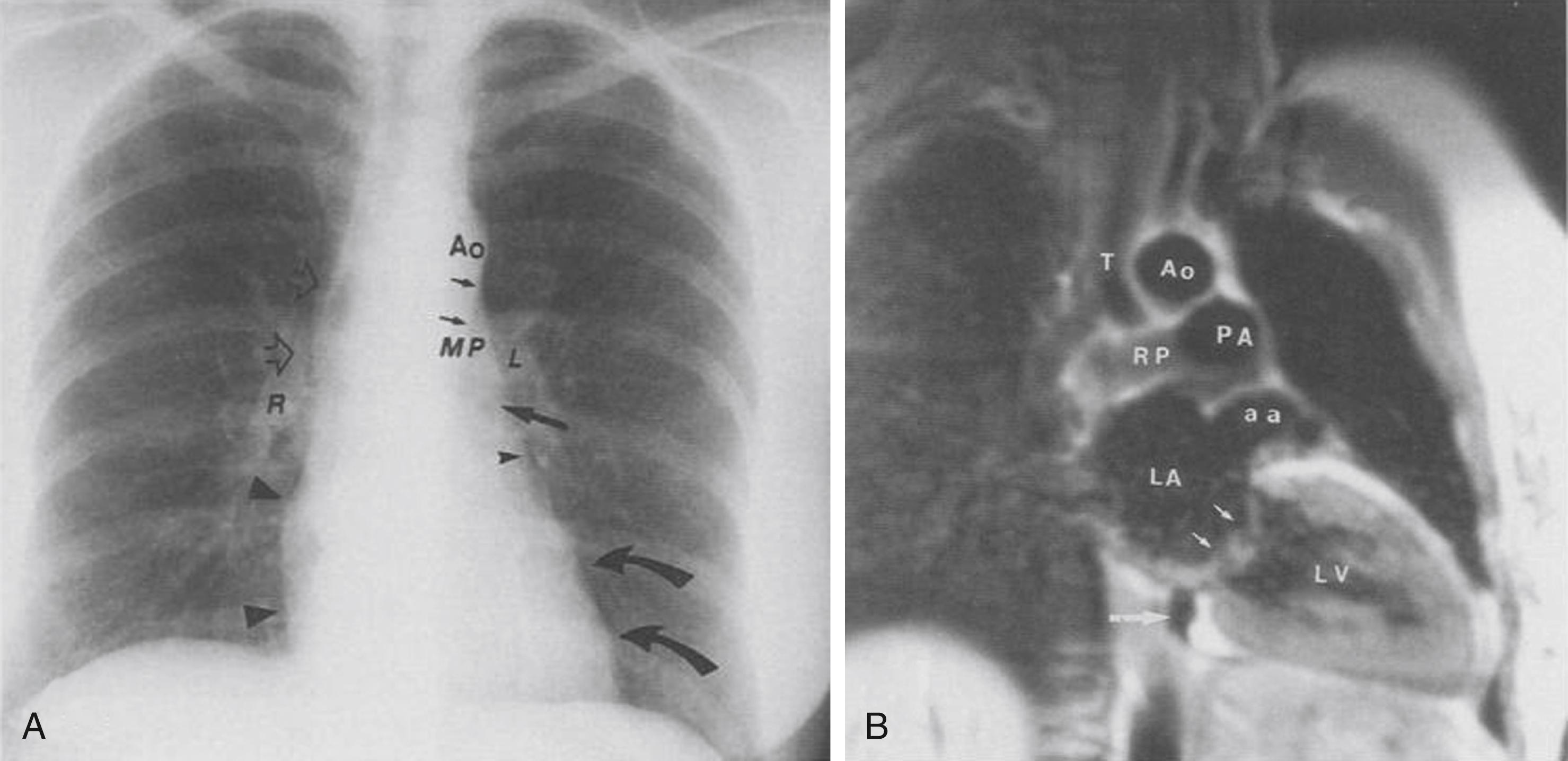
Manipulating preterm infants for radiographs must be done with care. Attention must be directed to maintaining oxygen levels, preventing cardiorespiratory complications, preventing heat loss, warming cassettes, and paying attention to good handwashing. Gonad/thyroid shielding is placed on top of the incubator rather than inside it. The cross-table lateral film is used when there is a possibility of free air (pneumothorax or pneumomediastinum). Because the infant is supine and air rises to the most nondependent location, air can be seen under the sternum.
The airway should be visible on all chest films. The trachea is not a midline structure (the carina projects adjacent to the right pedicles). Buckling of the trachea is normal. The airway is a dynamic structure that changes in caliber; however, if on all views the airway is persistently small, further investigation is necessary. It is normal for neonates and young infants to occasionally have some air in the esophagus (not so in older children). The ideal position of the endotracheal tube is at the level of the inferior margins of the clavicles, or about 1.5 vertebral bodies above the carina.
The aortic arch frequently cannot be seen in a neonate, and its position must be inferred from the position of the carina. If the carina overlies the right pedicles, the aortic arch is left-sided. A right-sided aortic arch may be inferred if the position of the carina is at the midline or to the left. A right aortic arch should alert the physician to the possibility of congenital heart disease (CHD) and/or a vascular ring. In neonates and infants, the cardiothoracic ratio can be up to 60% (the adult dimension is 50%). Measuring the heart size on an anteroposterior film is accurate in this age group because there is minimal magnification of the heart (unlike in adult anteroposterior chest radiographs). If the heart is large, it should appear so in both frontal and lateral views. On the lateral radiograph, the retrocardiac air space should be seen in a normal-sized heart, and the carinal line (a perpendicular line drawn from the carina to the diaphragm) should not intersect the heart. A second method to evaluate heart size on the lateral film is the anterior tracheal line (a line parallel to the anterior wall of the trachea that extends inferiorly to the diaphragm). This line should not intersect the heart, nor should the line be pushed back to traverse the spine above the diaphragm. Both methods work best on nonrotated lateral films. If a frontal film shows questionable cardiac enlargement, look at the lateral film. If the lateral film is normal, the heart size is normal.
In infants and older children, pulmonary vascular changes may help in detecting a left-to-right shunt circulation. In the newborn, however, the pulmonary vessels can be seen at the hila and only in the medial third of the lungs. When there is vascular congestion secondary to congestive heart failure or overcirculation from a left-to-right shunt, the vascularity becomes much easier to see in the lateral two-thirds of the lung. It is much more difficult to detect decreased pulmonary vascularity (as found in severe pulmonary stenosis or atresia).
Cyanotic heart disease may involve the following:
Increased pulmonary blood flow: Truncus arteriosus and total anomalous pulmonary venous return
Decreased pulmonary blood flow: Tetralogy of Fallot (TOF), Ebstein anomaly, and pulmonary atresia with intact ventricular septum
Variable flow: D-transposition of the great arteries and tricuspid atresia
Acyanotic heart disease may involve the following:
Normal pulmonary blood flow (obstructive lesions): Coarctation of the aorta, aortic stenosis, and pulmonary artery stenosis
Increased pulmonary blood flow (left-to-right shunt): Ventricular septal defect, atrial septal defect, atrioventricular septal defect, and patent ductus arteriosus
Left-sided anatomic obstruction may involve the following:
Coarctation of the aorta
Aortic stenosis
Left ventricular dysfunction may involve the following:
Abnormal origin of the left coronary artery
Myocarditis
Shock
Birth asphyxia
Hypoplastic left heart
Pulmonary venous atresia/stenosis
General systemic illness may involve the following:
Anemia
Polycythemia
Hypoglycemia
Sepsis
Extracardiac shunting such as congenital hemangioma of the liver and intracranial vein of Galen malformation ( eFig. 25.3 ).
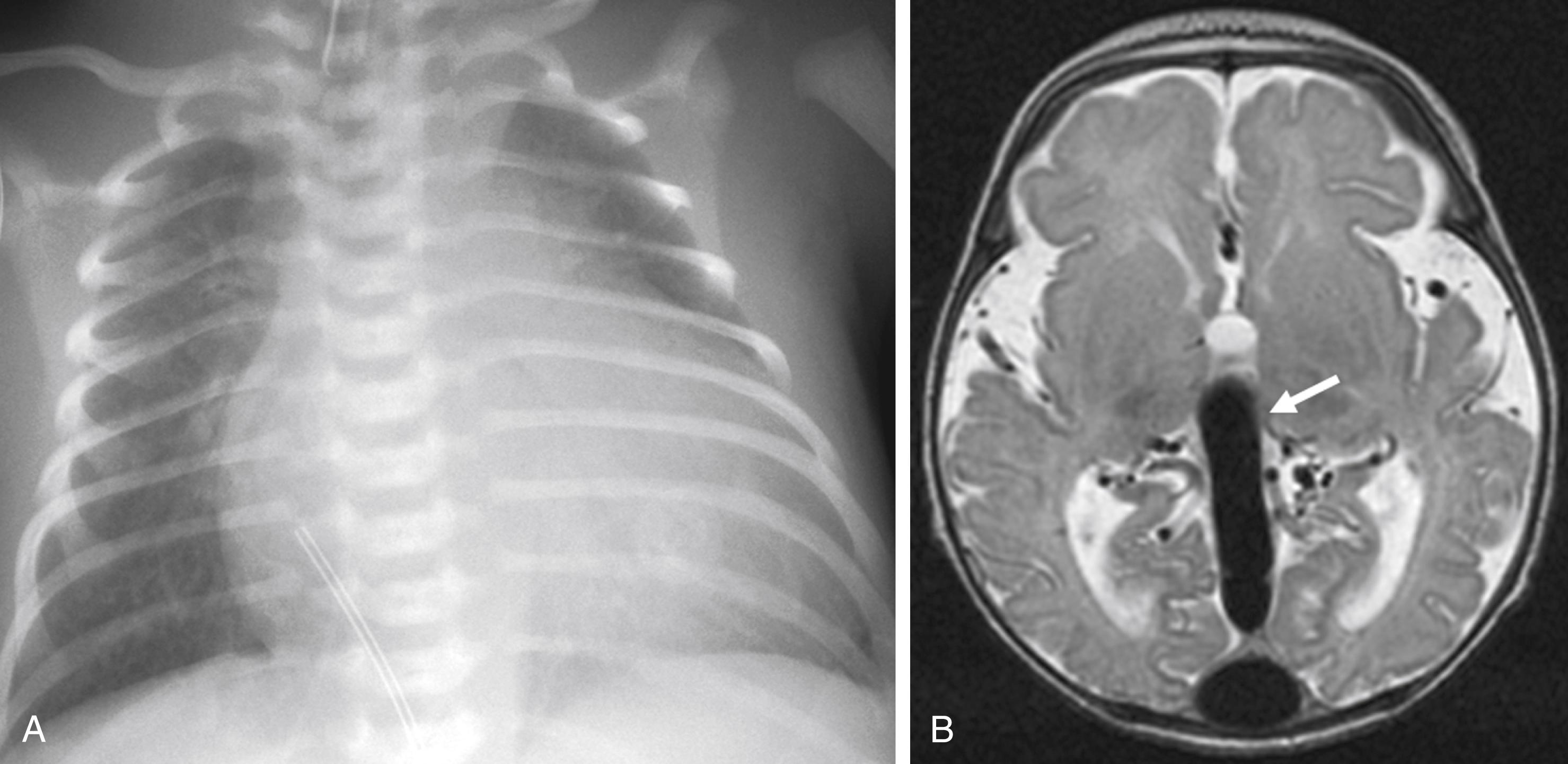
The differential diagnosis of the various diffuse pulmonary conditions is described in Table 25.3 . Premature infants are prone to complications related to therapy, such as:
Air leak secondary to barotrauma: Pulmonary interstitial emphysema, pneumomediastinum, pneumopericardium, pneumothorax, pneumoperitoneum, and air embolism
Misplaced or perforated tubes: If the infant who is intubated is having unexplained respiratory distress, two views (frontal and lateral) may help define tube position
Stone formation: Gallstones (secondary to hyperalimentation), and renal stones (secondary to diuretic therapy, e.g., furosemide)
Central nervous system (CNS) hemorrhage
Oxygen toxicity (retinopathy of prematurity)
Line infection and vascular thrombosis
| Hyaline Membrane Disease | Transient Tachypnea of the Newborn | Meconium Aspiration | Neonatal Pneumonia | |
|---|---|---|---|---|
| Typical patient | Premature | Term Cesarean section |
Post-term meconium-stained fluid below the vocal cords | Premature rupture of membranes |
| Time course | Within hours | 24–48 h | 12–24 h | Onset <6 h |
| Lung volume | Decreased | Increased | Increased | Increased |
| Radiographic characteristics | Ground-glass granular | Interstitial edema | Coarse, nodular, asymmetrical | Perihilar “streaking” |
| Effusions | No | Yes | No | Maybe |
| Complications and possible therapy | Pulmonary interstitial emphysema or pneumothorax, respiratory distress syndrome, patent ductus arteriosus | None | Persistent fetal circulation, extracorporeal membrane oxygenation (ECMO) | Sepsis, ECMO |
Lucent lesions may involve the following:
Congenital lobar emphysema
Congenital pulmonary airway malformation
Persistent pulmonary interstitial emphysema
Congenital diaphragmatic hernia
Solid lesions may involve the following:
Sequestration
Bronchogenic cyst
Congenital pulmonary airway malformation
The following outline is a useful summary of the etiology of mediastinal masses:
Anterior mediastinum (the four Ts and a C)
Thyroid (ectopic thyroid)
“Terrible” lymph node enlargement by either infection or malignancy
Teratoma
Thymoma
Cystic hygroma (lymphatic malformation)
Middle mediastinum (an abnormality for each organ)
Esophagus: Duplication cysts
Great vessels: Aneurysmal dilatation
Hila: Enlarged lymph nodes (leukemia, lymphoma, tuberculosis, and so on)
Trachea: Bronchogenic cysts
Pericardium: Cyst
Posterior mediastinum
Tuberculosis (Pott disease) or any spinal infection
Extramedullary hematopoiesis (almost always in adults)
Neural tumors: Neuroblastoma, ganglioneuroma, neurofibroma, neurenteric cyst
Tips when viewing mediastinal masses include the following: (1) middle mediastinal masses silhouette the heart border and aorta; and (2) posterior mediastinal masses may spread the ribs or cause vertebral changes.
The abdominal x-ray is the initial examination in the workup of abdominal and pelvic symptoms, and it may provide useful information for tailoring the examination to the individual patient’s problem. Supine and upright radiographs are obtained, although left lateral decubitus views are used in newborns and in ill or uncooperative patients. Single supine examinations may be obtained when the clinical suspicion is constipation or foreign body ingestion or if the examination is being performed for tube or catheter localization. On a cross-table lateral view, it may be difficult to differentiate intraluminal air from extraluminal air, and decubitus or upright views are more useful in that context.
The liver takes up a relatively larger space in the peritoneal cavity of a child. The spleen may not be visible and usually does not displace the gastric contour in a child. Likewise, retroperitoneal fat “stripes” (psoas shadows) are frequently not seen on a child’s radiograph because of the relative paucity of fat in the infant’s and small child’s retroperitoneum. The lack of fat in the capsules of the solid organs makes evaluation of their size nearly impossible on radiographs. In contrast, properitoneal fat stripes are visible from infancy. A soft tissue pseudomass in the abdomen may be the urinary bladder, the fluid-filled stomach or intestine, or an umbilical hernia. Children up to the toddler age group typically have air throughout the entire gastrointestinal (GI) tract.
Newborns should have air in the stomach at birth, consisting mainly of swallowed air. The small bowel should be filled with air by 6 hours at the latest; the colon by 12 hours; and by 24 hours of life, air should appear in the rectum, although rectal air is typically present much earlier (by 12 hours). A prone film is frequently helpful because air rises into the rectum when obstruction is not present. The normal newborn abdomen demonstrates monotonous polygons of gas. In neonates and infants, it is often impossible to reliably differentiate small from large bowel except for stomach and rectum, especially if the bowel becomes dilated.
Absence of air in the stomach at 1 hour of life should raise the possibility of esophageal obstruction: esophageal atresia without tracheoesophageal fistula. A gasless abdomen in an infant for more than 12 hours indicates a serious disease. The most common cause of a lack of intestinal air in the newborn is depression of crying and swallowing in ill babies, especially those with newborn lung disease. Other causes of a gasless abdomen are vomiting, medication that decreases peristalsis, obstruction of a fluid-filled bowel, peritonitis, ascites, and congenital diaphragmatic hernia (a chest radiograph is diagnostic). Other causes of disturbed swallowing and/or diminished peristalsis include septicemia, metabolic disorders, and fatigue. The neonate in whom an orogastric or nasogastric tube has been placed may have a relatively gasless abdomen without other underlying pathology. Absence of meconium passage by 24 hours is abnormal, and abdominal distention or marked dilatation of any viscus in the first day of life should lead to further imaging evaluation.
The ideal location for the tip of the umbilical venous line is in the right atrium. The umbilical arterial line tip may be at L4 to L5 (bifurcation of the aorta) or at T8 above the diaphragm ( Fig. 25.15C ). The course of the umbilical venous line is as follows: umbilical vein → umbilical recess → left portal vein → ductus venosus → inferior vena cava → right atrium (see Fig. 25.15A ). The umbilical arterial line dips inferiorly in the umbilical artery to join the internal iliac artery (creating a deep loop in the pelvis) and then rises posteriorly in the abdominal aorta (see Fig. 25.15B ). The lateral view can confirm which catheter is arterial (which will be posterior) and which is venous (which will appear anterior).
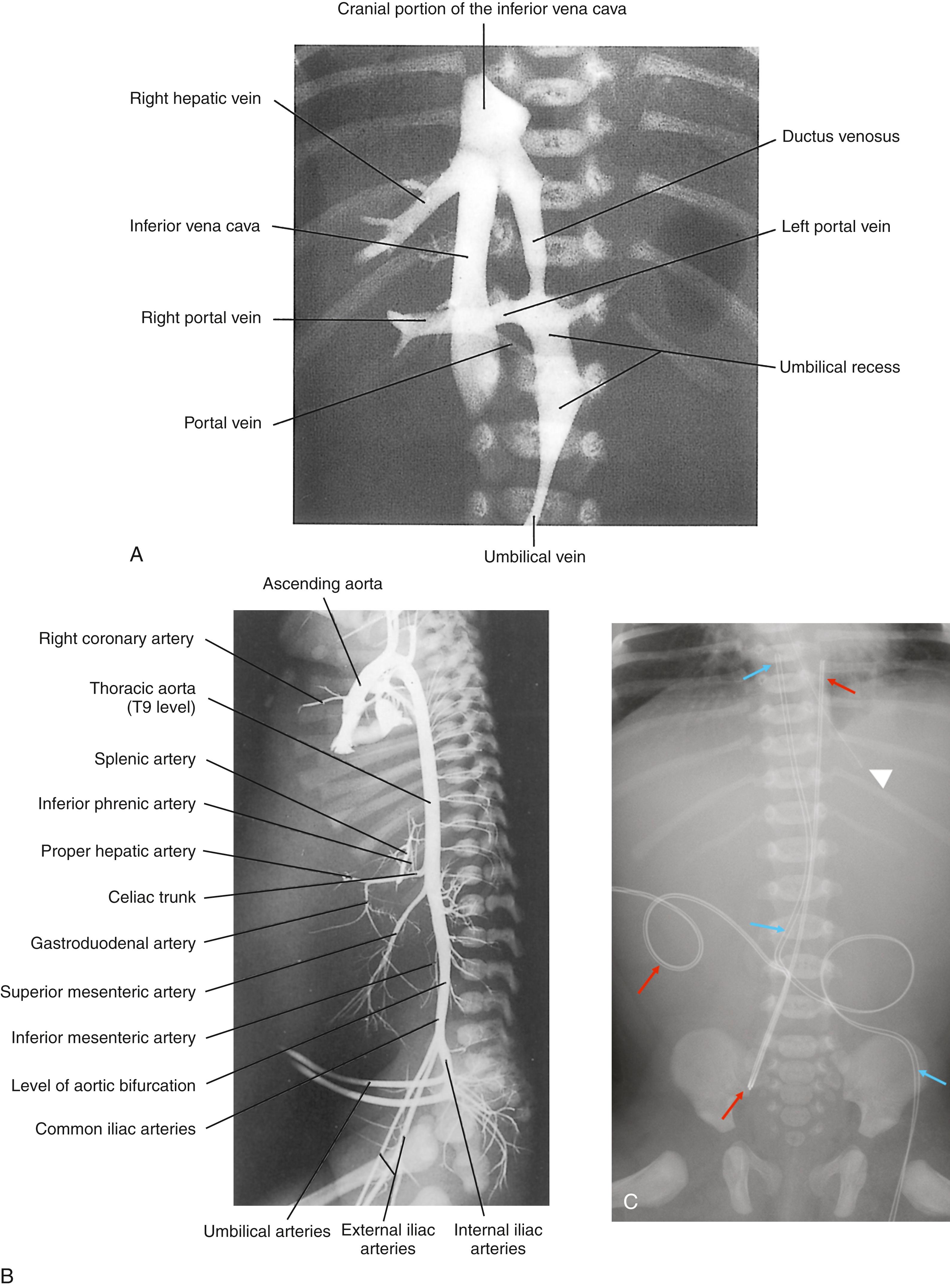
Ileus should be suggested only when loops of intestine are dilated. The presence of air in normal-caliber large and small bowel is a common and normal finding in newborns and infants. In adynamic (without peristalsis) ileus (distention), the small bowel is less distended than the colon, and there is gas in the rectum. In infants and older children, adynamic ileus occurs (1) after surgery, (2) with sepsis, (3) with gastroenteritis, (4) subsequent to electrolyte disturbances such as dehydration and hypokalemia, and (5) after administration of drugs such as opiates and anticholinergics.
A more uniform, generalized increase in all or parts of the small or large bowel along with multiple air/fluid levels and no air in the rectum denote mechanical bowel obstruction. The prone film is helpful in directing gas to the rectum for assessment of its caliber when bowel obstruction is a concern; a prone horizontal-beam (cross-table lateral) film of the rectum is helpful in these cases. The most common causes of mechanical obstruction in the neonate are as follows: (1) duodenal atresia or stenosis, (2) malrotation with midgut volvulus, and (3) obstructing peritoneal bands (Ladd bands). Beyond the neonatal period, the most common causes in descending order of frequency consist of (1) appendicitis, (2) intussusception, (3) inguinal hernia, (4) postoperative adhesions, (5) post–necrotizing enterocolitis strictures, and (6) midgut volvulus. In older children, valvulae conniventes and haustral markings may help differentiate dilated small bowel and large bowel, respectively, and the distended colon is more peripheral in location than the more centrally located distended small bowel. These findings may not be applicable in the neonate or the child with malrotation and midgut volvulus.
Free air in the peritoneal cavity most commonly results from perforation of a hollow viscus. Large amounts of free air are readily identifiable on supine abdominal radiographs, which may show the presence of the Rigler sign (where both sides of the bowel wall can be visualized), the football sign (where the liver is blacker than the adjacent soft tissues), and visualization of the falciform ligament. Small amounts of free air typically require a cross-table lateral, lateral decubitus, or upright view. A cross-table lateral supine view may show a long colonic collection of air mimicking pneumoperitoneum. Perforation of a hollow viscus typically leads to intraperitoneal air/fluid levels as intraluminal fluid, as well as air leaks into the peritoneal cavity. Other causes of pneumoperitoneum include (1) postoperative air and (2) tracking of air from pneumomediastinum, usually in children undergoing pressure ventilation and in asthmatic patients. The latter condition results when mediastinal air extends into the retroperitoneum and then along the course of the mesenteric vessels, resulting in subserosal air, which can rupture into the peritoneal cavity. It can be differentiated from visceral perforation by the lack of intraperitoneal air/fluid levels on horizontal-beam radiographs.
The abdominal radiograph can be used to assess calcifications, which may be present in meconium peritonitis, abdominal masses such as hepatoblastoma or neuroblastoma, and stones in the gallbladder, urinary tract, pancreas, or appendix. A phlebolith in an infant is definitely abnormal; it occurs far more often in adults.
Radiography remains the primary method of detecting and analyzing skeletal abnormalities. Most fractures and congenital deformities are sufficiently imaged by radiography without the need for additional imaging. The spatial resolution of radiography is superior to that of all other modalities. Radiography is cost-effective and radiation exposure to the patient is minimal. Radiographs often guide the selection of additional imaging modalities when needed. Adequate radiography must include imaging in at least two perpendicular directions.
The skeletal survey remains an important component in the evaluation of many patients with a skeletal dysplasia or syndrome and in suspected victims of child abuse. However, many surveys have largely been replaced by 99m Tc-methylene diphosphonate (MDP) nuclear scintigraphy, 18 F-fludeoxyglucose (FDG) PET/CT, and/or whole-body MRI for the detection of metastatic disease to the skeleton. Skeletal surveys are particularly useful in Langerhans cell histiocytosis (LCH) when skeletal scintigraphy may be falsely negative.
Radiographs are less relevant to evaluate the soft tissues because of their narrow contrast range, but plain films can depict soft tissue swelling, calcifications, fat, gas, or foreign material within a soft tissue lesion, and can show the effect of the lesion on the adjacent bone.
Bone develops by intramembranous (flat bones) and endochondral (long bones) ossification. The long bone of a child is made up of four parts: the physis, or growth plate, and the epiphysis, metaphysis, and diaphysis. Each long bone (humerus, tibia) has a physis, and thus metaphysis and epiphysis, on either end. A secondary ossification center appears in the epiphysis after birth. Some long bones (e.g., the femur) have a nonarticulating apophysis, which is similar to the epiphysis but does not contribute to the length of the bone (e.g., the greater trochanter of the femur).
In the growing child’s skeleton, blood supply is primarily to the metaphysis, and many of the disease processes and imaging findings are seen in this region. For example, hematogenous osteomyelitis is visible most often in the metaphysis; similarly, metastases travel hematogenously to the metaphysis.
The child’s bones are still growing, developing, and modeling; therefore, many ossification centers are constantly appearing and fusing with the main skeleton. For example, the mnemonic “CRITOE” refers to the approximate age of ossification of secondary centers in the elbow: c apitellum (1 year), r adial head (4 years), i nner (medial) epicondyle (7 years), t rochlea (10 years), o lecranon (10 years), and e xternal (lateral) epicondyle (11 years).
In children the periosteum is less firmly attached to the diaphysis (or shaft) of the long bone and is more likely to tear and thus be elevated by trauma or hematoma formation. The periosteum reacts by laying down a thick layer of new bone. In contrast, the periosteum at the ends of the long bones is not loosely attached but rather firmly adherent to the metaphyseal regions. Shaking injuries here cause avulsion of a piece of bone from the metaphysis. This type of “bucket-handle” injury or avulsion “corner fracture” is commonly found in cases of child abuse (see Chapter 6 ).
The most common indication for radiography is the assessment of trauma. As a general rule, two orthogonal views are obtained to assess for fracture. When imaging a long bone, both the proximal and distal joints must be included so that the entirety of the bone is imaged.
Contralateral comparison views may aid in differentiating normal developmental variation from pathology. Comparison views are most helpful in areas of complex anatomy, such as the elbow with its six ossification centers. Normal variants are common and may mimic a fracture.
The child’s bones are more plastic and less brittle than adults and so pediatric fractures differ from adult fractures. The greenstick fracture is characterized by a bowed long bone with a break on the convex surface but apparent cortical continuity on the concave surface. In the torus fracture, there is buckling on one side of the cortex.
Some fractures are more prevalent in different age groups. For example, infants previously able to walk may suddenly limp because of a subtle spiral fracture of the tibia (a toddler’s fracture ). This fracture can be difficult to see on initial films. If there is suspicion that a fracture has occurred but none is definitely identified, repeat films in 7 to 10 days, or a nuclear medicine bone scan may help. Periosteal reaction around a fracture indicates healing and means that the injury is certainly more than several days old.
Periosteal reaction, with the exception of so-called physiologic appositional new bone found symmetrically in infants 2 to 6 months old, should be regarded as abnormal. The normal physiologic periosteal bone deposition is bilaterally symmetrical and found in the humeri, femora, and tibias and extends to the metaphysis but no further. The periosteum is normally not seen.
Causes of periosteal reaction include (1) infection, (2) trauma, (3) metabolic disturbances (rickets, scurvy), (4) tumors (osteosarcoma, Ewing sarcoma, histiocytosis), (5) idiopathic origin (Caffey disease), and (6) iatrogenic/toxic origin (prostaglandin, hypervitaminosis A).
If a fracture involves a joint, then a joint effusion (particularly in the knee or elbow) is a useful sign indicating that a fracture may have occurred. At the elbow, a joint effusion most likely indicates that a supracondylar fracture (younger child) or radial neck fracture (older child) has occurred.
Fractures involving the growth plate are called Salter-Harris fractures and carry a prognostic rating according to the severity of the growth plate injury (types I to V, with type V being the worst; see Chapter 22 ). Severe length discrepancies and other growth disturbances can occur from fractures in these regions.
The skeleton of children is unique in that it has a low incidence of dislocations of otherwise normal joints as compared with the adult skeleton. Because children’s capsular and ligamentous structures are two to five times stronger than the weakest part of the growth plate, the growth plate fractures first, and dislocation occurs less frequently. The zone of calcifying cartilage is the weakest portion of the growth plate.
If the imaging findings are suspicious, it is the radiologist’s legal obligation to report these findings as compatible with child abuse. Usually, reporting the findings to the referring (pediatric) clinician, either in the report or via telephone (preferable), is sufficient. See Chapter 6 for an in-depth discussion of nonaccidental trauma.
With short stature in the pediatric age group, it is crucial to clinically determine whether the skeletal dysplasia involves proportionate or disproportionate short stature. The differential diagnosis of proportionate short stature consists of constitutional delay, familial short stature, a small group of endocrinopathies, and some dysmorphology syndromes. A left hand-and-wrist radiograph for bone age determination is required. For the bone age to be considered normal, it should lie within 2 standard deviations of the patient’s chronologic age. Most of the bone dysplasias result in clinically disproportionate short stature. The skeletal survey for dysplasia need only include the limbs on one side of the body. See Chapter 22 for an in-depth discussion of skeletal dysplasias.
Clear radiographic signs of a benign lesion include sharp demarcation between the lesion and the normal bone, a sclerotic margin around the lesion, and a nonaggressive pattern of growth. The characteristics most often associated with a malignancy include an accompanying soft tissue mass, periosteal reaction, an indistinct zone of demarcation between the normal and abnormal bone, and permeative, destructive changes in the bone. Plain film radiography is usually adequate to diagnose most benign tumors. MRI is the modality of choice to define the extent of the abnormality once a malignant bone lesion has been suggested.
The clinical symptoms of osteomyelitis precede the radiographic findings by 7 to 14 days. For this reason, bone scan or MRI is frequently more helpful in the early diagnosis of acute osteomyelitis.
The radiographic findings of acute osteomyelitis (0 to 2 weeks) include (1) soft tissue swelling initially, (2) loss of cortical margin, (3) focal demineralization of bone, and (4) faint periosteal new bone formation (7 to 14 days after onset).
The radiographic findings of the healing phase (>4 weeks) include (1) destroyed bone with irregular areas of sclerosis and lysis; (2) sequestrum, that is, a dense devascularized bone fragment within an area of pus and granulation tissue; and (3) involucrum, that is, a peripheral shell of supporting bone laid down by the periosteum around the old disease.
Chronic osteomyelitis (either unusual localized osteomyelitis or improperly treated) appears as (1) diffuse bone production with little or no destruction and (2) an occasional draining sinus or lucent area in the midst of the sclerotic bone.
For a summary of the indications, contraindications, advantages, and disadvantages of fluoroscopy in pediatric imaging, see Table 25.4 .
| Organ System | Common Indications | Contraindications/Precautions | Advantages | Disadvantages |
|---|---|---|---|---|
| Airway/chest (noncontrast) | Laryngomalacia Tracheomalacia Vocal cord paralysis Diaphragm paralysis |
None Widely available Dynamic Requires no contrast or sedation |
Noninvasive | Radiation exposure Requires brief immobilization of uncooperative children |
| Gastrointestinal Tract (Contrast-Enhanced) | ||||
| UGI series | Vascular ring or pulmonary sling Tracheoesophageal fistula Esophageal stricture Hiatal hernia Gastroesophageal reflux Gastritis Peptic ulcer disease Gastric outlet obstruction (sonography favored for HPS) Duodenal stenosis or atresia Malrotation/midgut volvulus |
Hyperosmolar water-soluble contrast is contraindicated in patients with reflux or tracheoesophageal fistula Barium is contraindicated in patients with perforation or leak |
Noninvasive (or minimally invasive if feeding tube required) Widely available Dynamic Requires no sedation |
Radiation exposure Requires ingestion of contrast or tube feeding Requires brief immobilization of uncooperative children |
| Oropharyngeal motility examination | Swallowing dysfunction | Examination should be terminated if severe aspiration occurs Because of a high risk of aspiration in population studied, barium is the contrast agent of choice Hyperosmolar water-soluble contrast is contraindicated |
Allows dynamic assessment of oropharyngeal motility (not included in standard UGI series) Noninvasive Requires no sedation |
Requires radiation exposure (often more than for UGI series) Requires contrast/food ingestion and patient cooperation Must be scheduled in advance to ensure simultaneous radiologist and speech pathologist availability |
| Small bowel series | Small bowel obstruction, pseudo-obstruction, or atresia Malabsorption or immune deficiency Inflammatory bowel disease Mass Short-gut syndrome |
Same as for UGI series | Allows assessment of small bowel distal to DJJ (not included in UGI series) Noninvasive (or minimally if feeding required) Requires no sedation |
Requires radiation exposure (more than for UGI series alone) Requires ingestion of contrast or tube feeding Requires brief immobilization of uncooperative children May take several hours to complete |
| Contrast enema a (single contrast) | Distal small bowel obstruction Colonic atresia Microcolon Meconium plug Meconium ileus or equivalent Hirschsprung disease Assessment of postoperative anatomy |
To avoid perforation, contrast enemas are relatively contraindicated in patients with necrotic bowel, toxic megacolon, pneumatosis intestinalis, or peritonitis In patients with known bowel perforation or recent surgery, water-soluble contrast is preferred over barium |
Minimally invasive Requires no sedation |
Requires radiation exposure Requires rectal tube Requires brief immobilization of uncooperative children |
| Air-contrast enema | Inflammatory bowel disease Polyposis or colonic mass |
In neonates and infants at risk for dehydration, iso-osmolar water-soluble contrast or barium is preferred over hyperosmolar water-soluble contrast | ||
| Air enema | Intussusception | Bowel perforation | Advantage over contrast enema: Smaller tears and reduced fecal spillage when bowel perforation occurs | Disadvantage over contrast enema: Slightly higher rate of bowel perforation |
| Contrast Urography | ||||
| Intravenous urography | Urinary calculi | Contrast allergy Renal insufficiency or failure |
Minimally invasive | Results in radiation exposure Requires intravenous contrast Less sensitive than CT for calculi |
| Voiding cystourethrography (VCUG) | UTI Hydronephrosis or hydroureter VUR Enuresis Cloacal and/or anorectal malformations Ambiguous genitalia Neurogenic bladder Posterior urethral valve Other urethral anomalies (i.e., stricture, polyp) |
Acute UTI Prophylactic antibiotics warranted in patients with CHD Latex avoidance in patients at risk for latex allergy |
Minimally invasive More sensitive to grade 1 VUR than nuclear cystography Provides better anatomic resolution than nuclear cystography |
Results in more radiation exposure than nuclear cystography |
a Precaution: A manometer and pop-off valve must be used to keep intraluminal pressure below 120 mm Hg; intravenous access and surgical backup must be secured before the procedure is begun.
For a summary of fluoroscopic contrast agents, see eTable 25.3 .
| Agent | Uses | Advantages | Risks | Contraindications |
|---|---|---|---|---|
| Barium | GI imaging only | Chemically inert Not absorbed Better tolerated than hyperosmolar water-soluble contrast agents if aspirated Better tasting and less expensive than water-soluble contrast agents |
Causes scarring when extravasated into peritoneal cavity Interferes with other imaging studies (CT, ultrasonography, nuclear scintigraphy) |
Potential GI tract leak Recent GI tract surgery |
| Water-soluble contrast agents | GI, urologic, neurologic imaging | Safer than barium if extravasated into peritoneal cavity or mediastinum | Risks (reduced with iso-osmolar nonionic agents) Severe chemical pneumonia if aspirated Severe dehydration (secondary to fluid shift into GI tract, especially in neonates) Altered hemodynamics Allergic reaction (especially after intravenous injection) Nephrotoxicity (after intravenous injection) |
Relative contraindications Known contrast allergy Renal insufficiency or failure Dehydration or shock |
In diaphragm paralysis, fluoroscopy is reserved for patients in whom ultrasound has been unsuccessful or has given results contrary to the clinical impression, such as when the ultrasound results are normal but the patient cannot be weaned from the ventilator.
The movement of the hemidiaphragm is complex. The left hemidiaphragm may occasionally be higher than the right, and unequal movement is common. The anterior part (dome) is the only part of the hemidiaphragm routinely visualized on frontal fluoroscopy. Lateral or oblique fluoroscopy is often useful but occasionally may be difficult to interpret and can be hazardous to a sick child.
In the right lateral position, the airway is observed for backward bowing of the epiglottis or fluttering of the aryepiglottic folds (laryngomalacia) and tracheal caliber change (tracheomalacia) or deviation. Laryngomalacia is noisier on quiet breathing, whereas tracheomalacia is noisier with crying.
For an upper gastrointestinal (UGI) series or esophagography, the patient should have nothing by mouth for 3 to 4 hours (infants) or 6 to 8 hours (older children). Observe swallowing while the child is in the right lateral position. Note sucking, swallowing coordination, nasopharyngeal reflux, vocal cord penetration, or tracheal aspiration. Examine the esophagus for stricture, indentation, fistula, and peristalsis. The aortic arch and left atrium are often seen as normal indentations. Anterior indentation of the esophagus with soft tissue structure interposed between esophagus and trachea represents a pulmonary artery sling ( Fig. 25.16 ). Posterior vascular indentation represents an aberrant subclavian artery (see Fig. 25.16 ).
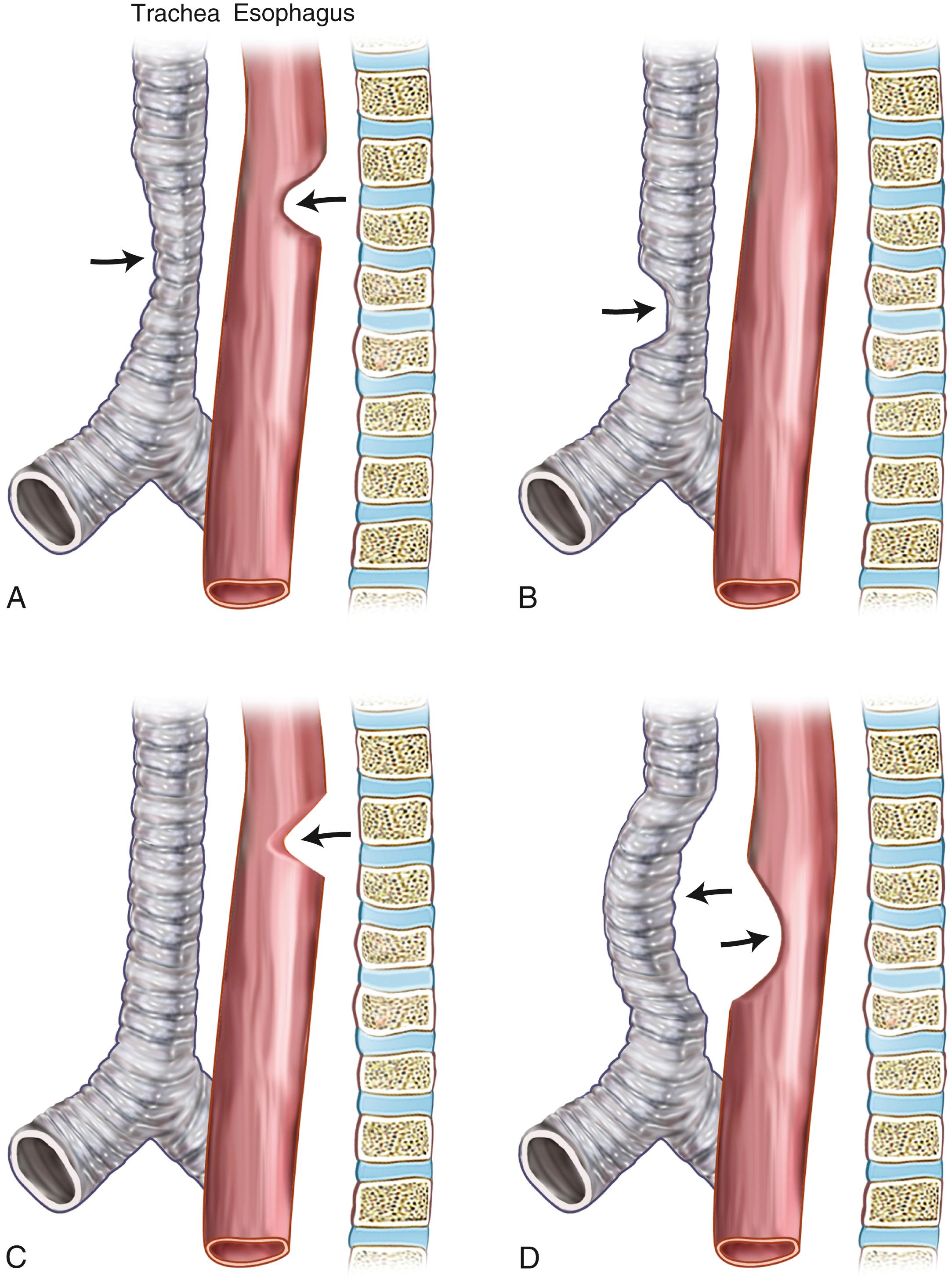
With the child in the right lateral position, the partially filled stomach should be observed until it empties into the duodenum. Gastric size, shape, and emptying should be noted. Duration of gastric emptying is variable in normal infants and children. Elongation of the pylorus combined with the “string sign” indicates pyloric stenosis. Identify the duodenojejunal junction (DJJ) position to exclude or confirm malrotation. The normal position of the DJJ is to the left of the spine and at the level of the bulb/pylorus ( Fig. 25.17A ). On the lateral view, both the descending (D2) and ascending (D4) segments of the duodenum are retroperitoneal structures (i.e., close to the spine) (see Fig. 25.17B ). The DJJ is also posterior in location on the lateral view. Evaluate for gastroesophageal reflux (GER). The UGI series has an overall lower sensitivity for reflux (38%, compared with 88% with a radionuclide study).
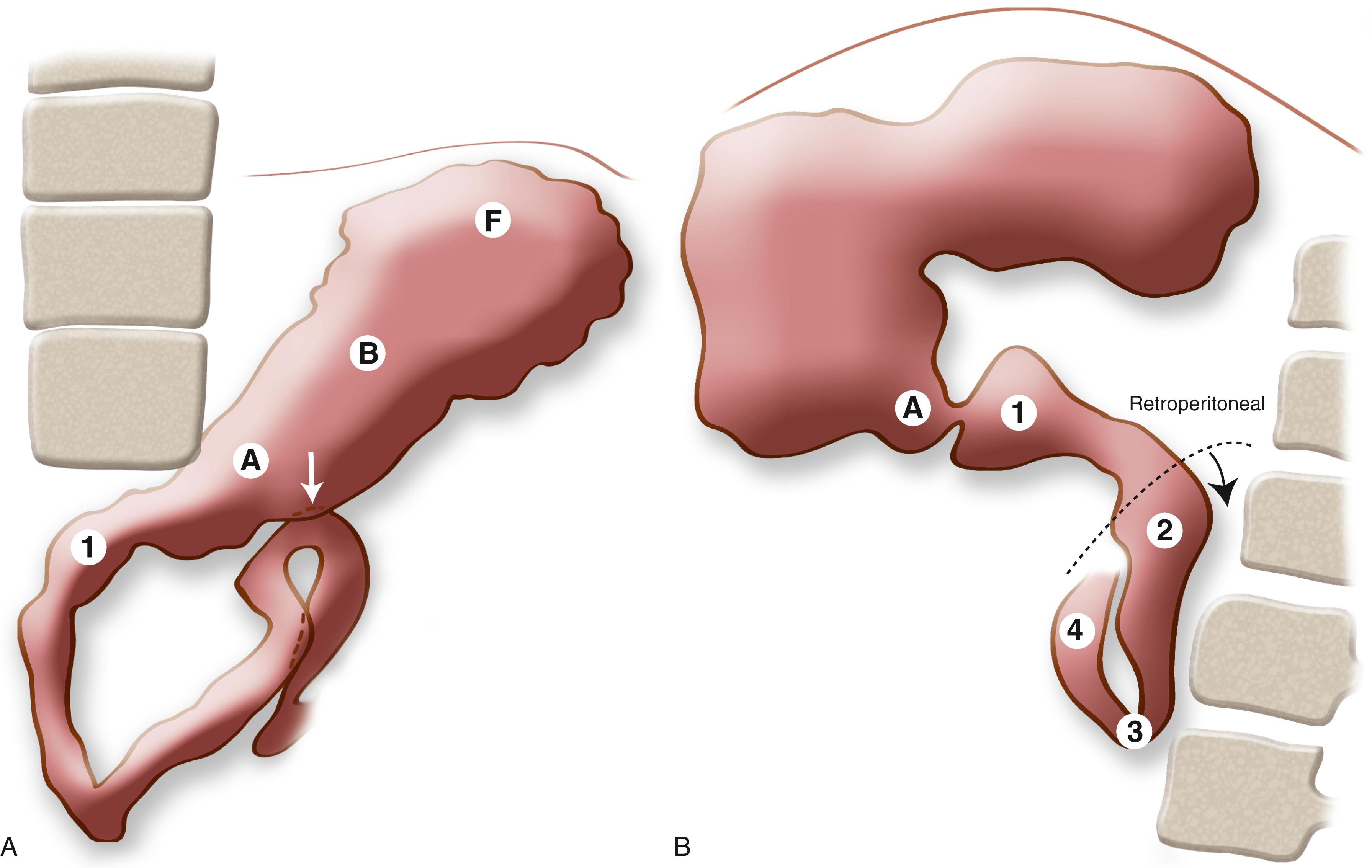
Proximal neonatal bowel obstruction (occurring proximal to the mid-jejunum) includes midgut volvulus ( Fig. 25.18 ), duodenal atresia, duodenal stenosis, duodenal web, annular pancreas, and proximal jejunal atresia. Patients usually present with vomiting. Abdominal radiographs demonstrate a few dilated small bowel loops.
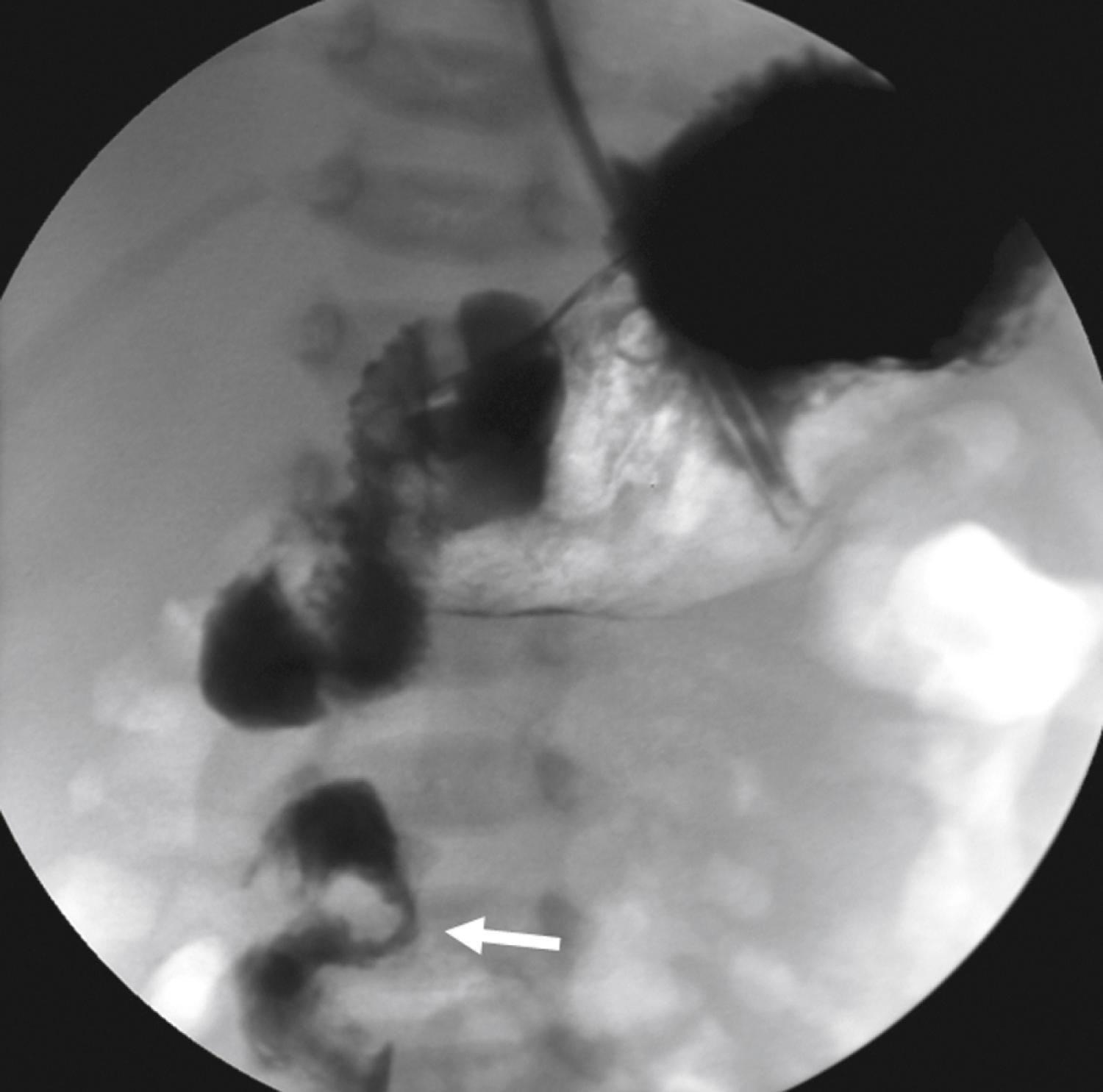
Diagnostic contrast enema is performed to identify causes of lower GI bleeding (i.e., polyps), small bowel obstruction (i.e., intussusception or distal bowel atresia), complications of inflammatory disease (i.e., post–necrotizing enterocolitis strictures), and to evaluate functional abnormality (i.e., Hirschsprung disease) or structural anomaly (i.e., imperforate anus before complete repair). A UGI study is preferred for evaluation for malrotation because contrast enema will miss the diagnosis in 20% of cases (because the cecum is malpositioned in 80% of patients with malrotation and is normally located in the right lower quadrant in the remainder of patients). Low neonatal bowel obstruction (involving the distal jejunum, ileum, or colon) includes meconium ileus, ileal atresia, Hirschsprung disease, and meconium plug syndrome ( Fig. 25.19 ). Patients present with abdominal distention and failure to pass meconium.
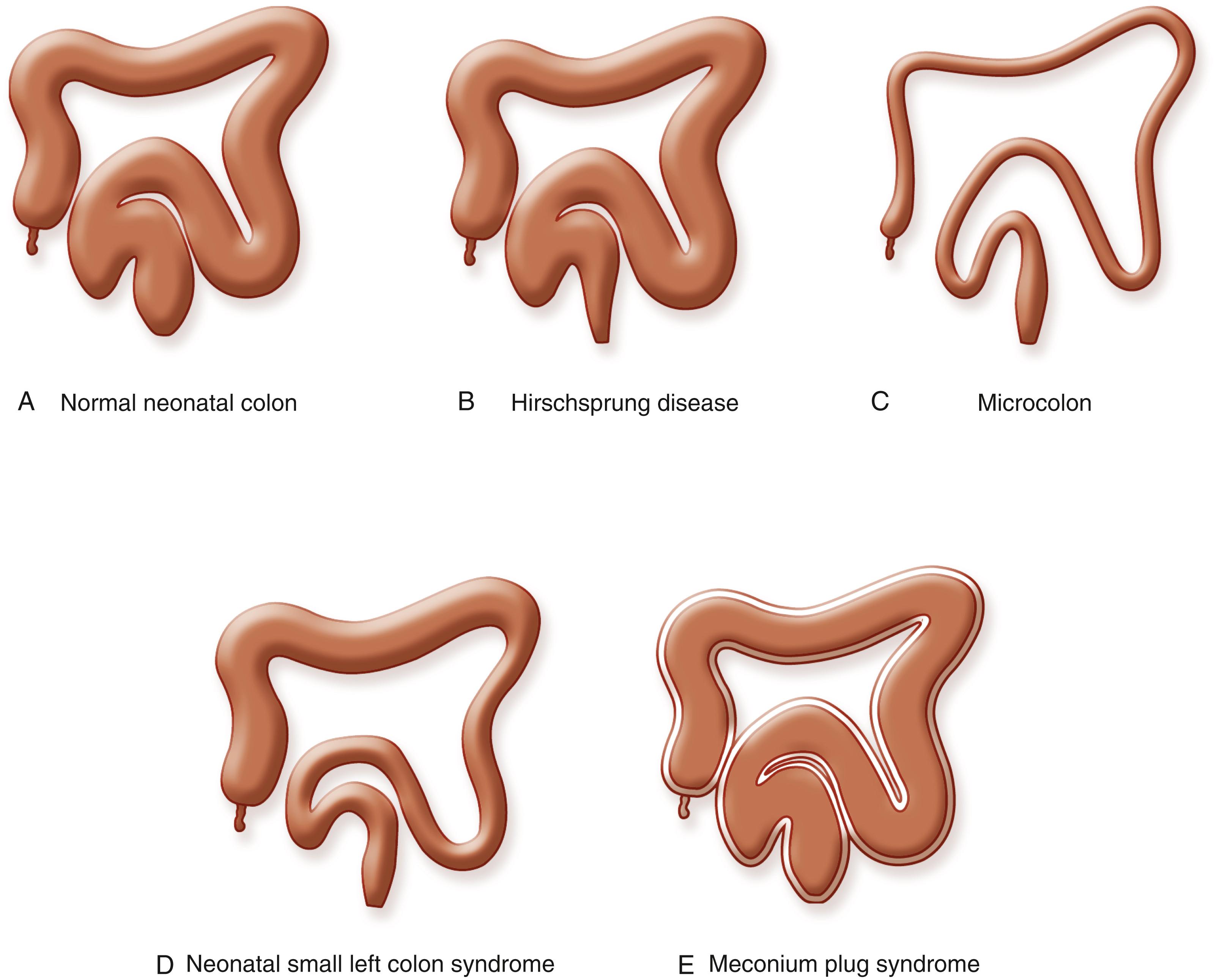
Barium or water-soluble contrast (osmolality, 600 mOsm/kg; diluted 1:1 in water) is used. Mucosal detail depicted with barium is better than that shown by water-soluble contrast. In the setting of Hirschsprung disease, barium can harden and remain in the colon as a barium ball. Barium can cause scarring when extravasated into the peritoneal cavity; therefore, it is contraindicated in potential GI leak and after recent GI surgery. Water-soluble contrast material can soften meconium plugs and can be used to treat meconium ileus. Administration of barium into the GI tract can interfere with subsequent CT scans of the abdomen or with nuclear studies of the genitourinary (GU) or GI system, such as a Meckel scan. If an abdominal CT scan is contemplated, a barium swallow or UGI series should follow the CT scan, rather than vice versa.
The caliber of the rectum should be compared with that of the sigmoid colon. Normally, the rectum is larger than the sigmoid colon, for a rectosigmoid ratio greater than 1 (in Hirschsprung disease, the rectum typically is smaller than the sigmoid).
Fluoroscopy-guided air or water-soluble contrast reduction of intussusception is the treatment of choice after sonographic confirmation (see the Ultrasound section, later). Contraindications to image-guided reduction include peritonitis, pneumoperitoneum, shock, and sepsis. The choice of enema medium depends on the radiologist’s preference. At present, an air enema is considered superior at reduction, cleaner (based on the appearance of the peritoneal cavity at surgery when perforation occurs), and faster with less radiation when compared with a liquid enema. A water-soluble enema is recommended for infants younger than 6 months old. Barium is no longer the liquid contrast medium of choice for intussusception reduction because of the risk of barium peritonitis, infection, and adhesions if perforation occurs during the enema. Radiologists should strive for enema reduction rates of 80%, but it will depend on their patient population. Neither sedation nor medications increase the enema success rate. Predictors of failure of pneumatic reduction include ileoileocolic intussusception (27%), long duration of symptoms (>2 days), and performance following failed hydrostatic reduction. The perforation rate is about 0.8% and will require immediate surgical intervention. Reduction should not be attempted without surgical backup, and all children should have surgical consultation before enema. Some reports estimate that the rate of spontaneous reduction based on sonographic and/or enema diagnosis before surgery is 10%.
Insufflated air rapidly fills the colon and outlines the head of the intussusception. Air pressure should be kept below 120 mm Hg to avoid the risk of perforation.
Reduction is defined as complete elimination of the intussusceptum through the ileocecal valve and free reflux of air into the distal small bowel ( Fig. 25.20 ). Perforation complicating air enema may cause tension pneumoperitoneum; some centers advise having an 18-gauge needle readily available in the fluoroscopy room for emergency decompression.
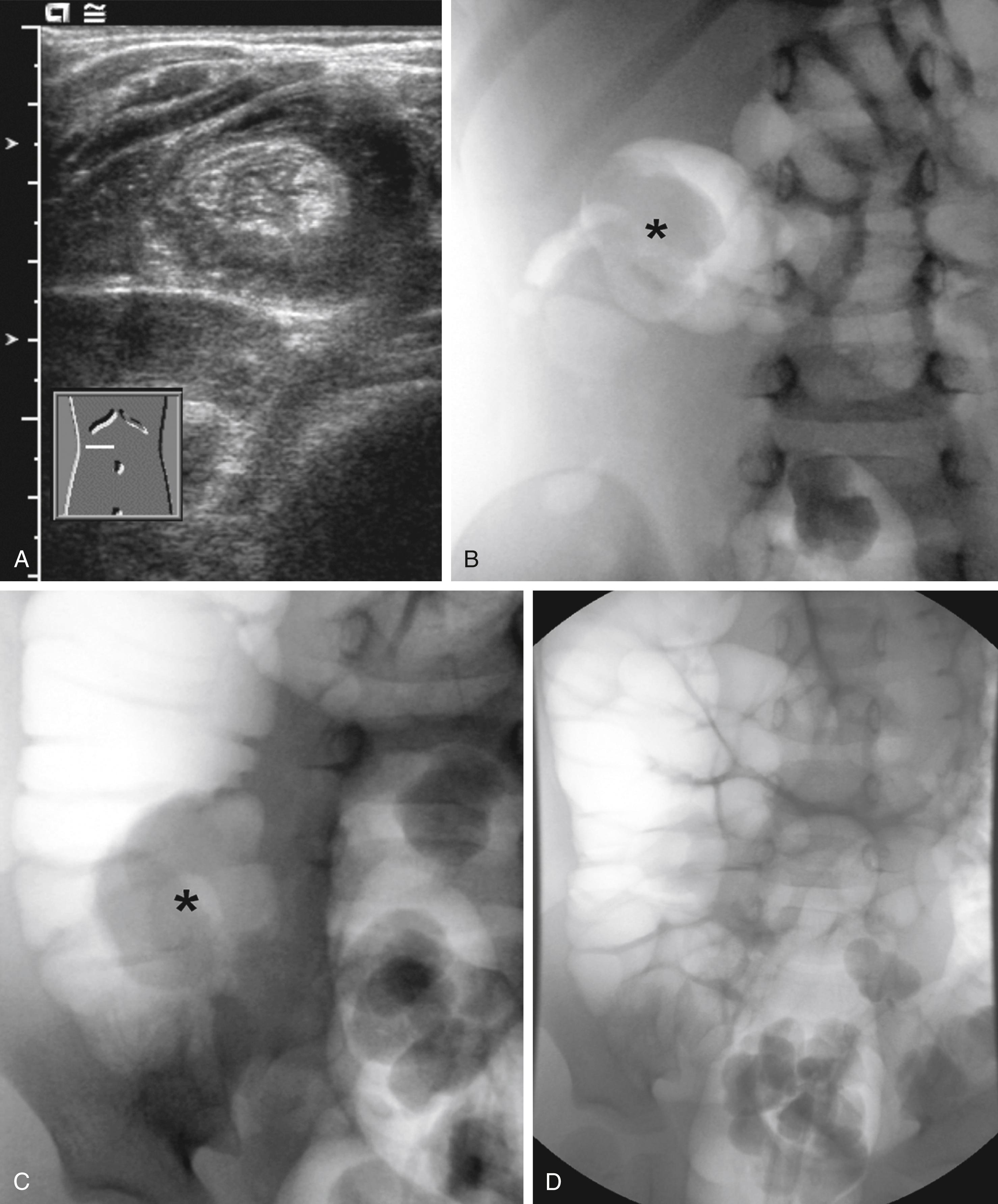
The recurrence rate is 10% postreduction. There is no contraindication to re-attempting to reduce the intussusception by an enema procedure. Many centers refer patients to surgery after more than three recurrences in order to evaluate for underlying pathologic lead points (PLPs). Approximately 5% to 6% of intussusceptions in children are caused by PLPs, which are due to either focal masses or diffuse bowel wall abnormality. The most common focal PLPs are (in decreasing order of incidence) Meckel diverticulum, duplication cyst, polyp, and lymphoma. Diffuse PLPs are most commonly associated with cystic fibrosis or Henoch-Schönlein purpura. The rate of detection of PLPs by ultrasound, liquid enema, and air enema is 66%, 40%, and 11%, respectively.
Contrast enemas may be used for reduction of uncomplicated meconium ileus (see Fig. 25.19C ). The study should be performed in conjunction with a pediatric surgeon.
No preparation of the colon is necessary when performing contrast enema for Hirschsprung disease. Recent manipulation including rectal examination or rectal thermometry shortly before contrast enema can make diagnosis more difficult by decompressing the distended colon. Normally, the rectum is larger than the sigmoid colon (in Hirschsprung disease, the rectum typically is smaller than the sigmoid). Identify a transition zone between the narrowed distal aganglionic segment and the dilated proximal, normal colon. Although contrast enema remains a useful test, suction biopsy provides definitive diagnosis.
Contrast enema can help differentiate between true and pseudofecal incontinence. In the setting of true fecal incontinence, the rectum is not dilated, whereas it shows significant dilatation in pseudofecal incontinence ( Fig. 25.21 ).
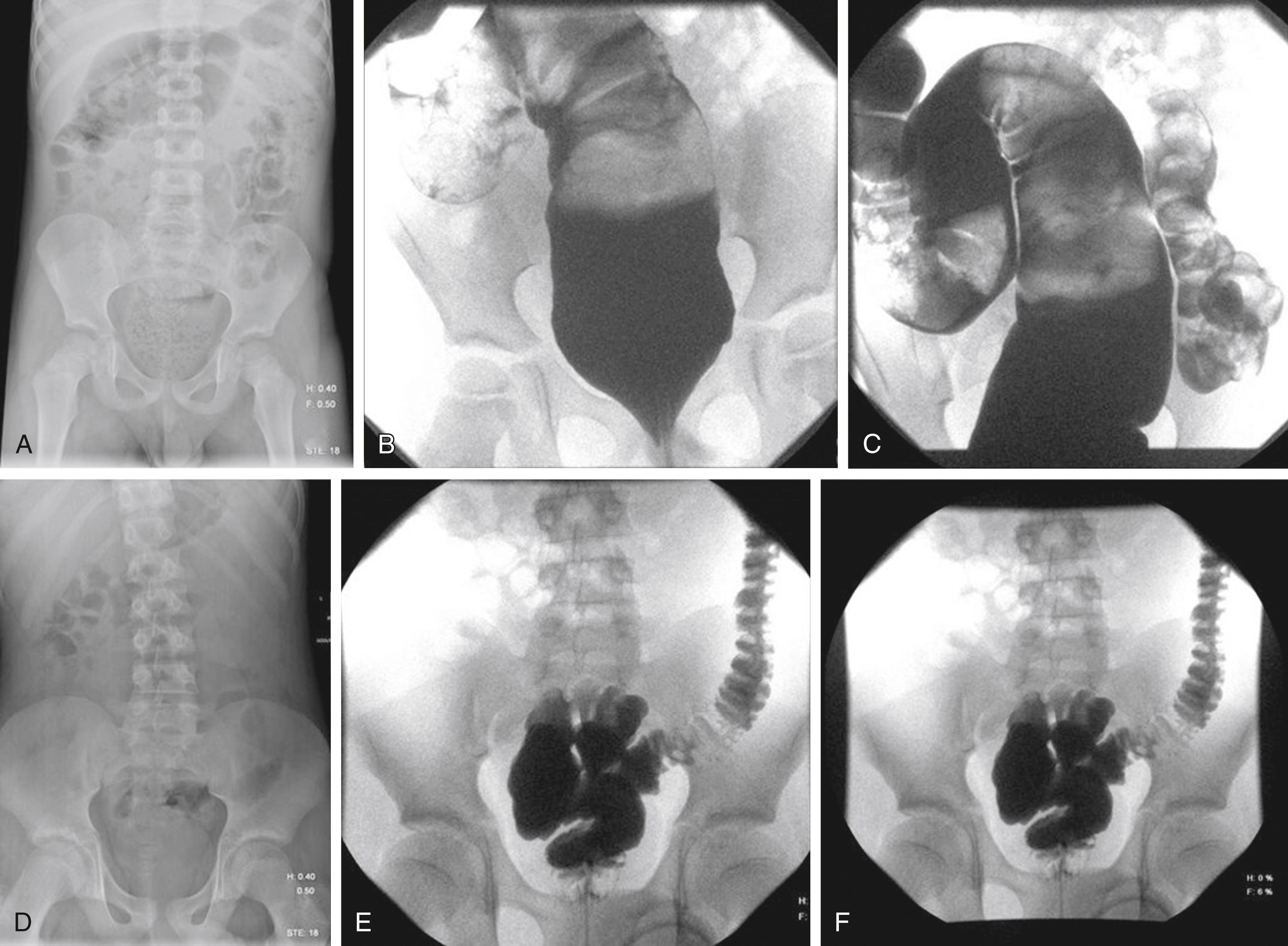
Voiding cystourethrography (VCUG) requires bladder catheterization using sterile technique. For male patients, lidocaine (xylocaine viscous 2%) can be placed into the penile meatus to locally anesthetize the urethra and make catheterization less painful. Catheterize the urethra with an appropriately sized catheter (5-French feeding tube for newborns and young infants or girls younger than 2 to 4 years old, 8-French feeding tube for older children, 10- to 12-French rubber catheter for teenagers). Under fluoroscopic guidance, the bladder is filled with iodinated contrast. The size, shape, and capacity of the bladder are noted, and the dome of the bladder is examined for irregularities, the presence of filling defects (mass or ureterocele), or sinus tract (urachal remnant). While on the fluoroscopy table, the patient is asked to void ( Fig. 25.22 ). As the child voids, the caliber of the urethra and dilatation of the posterior urethra are noted ( Fig. 25.23 ), as well as caliber change and completeness of voiding. The predicted bladder capacity (in milliliters) for children younger than 1 year is the child’s weight in kilograms multiplied by 7. In children older than 1 year, the predicted capacity is the child’s age in years plus 2, multiplied by 30.
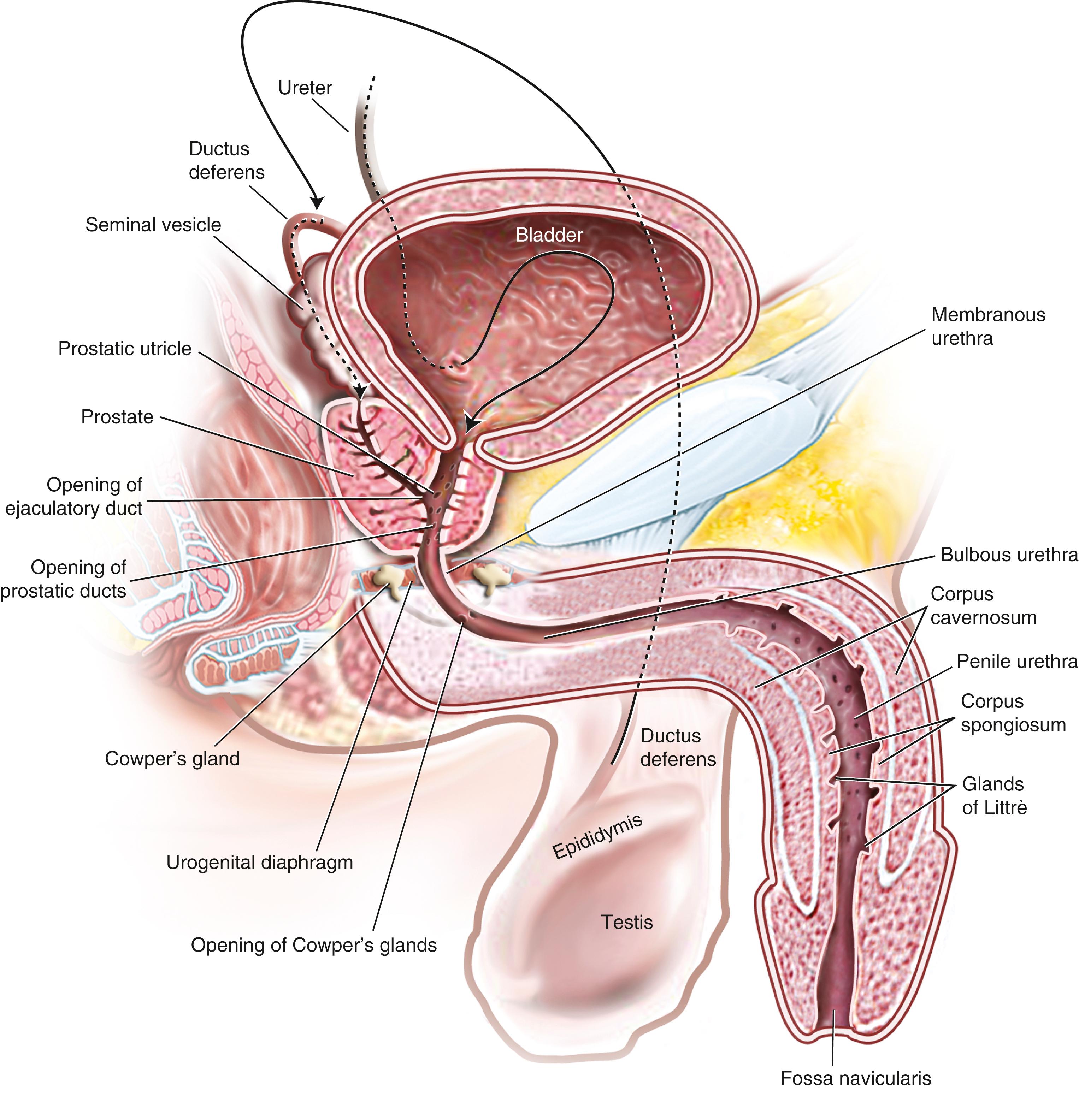
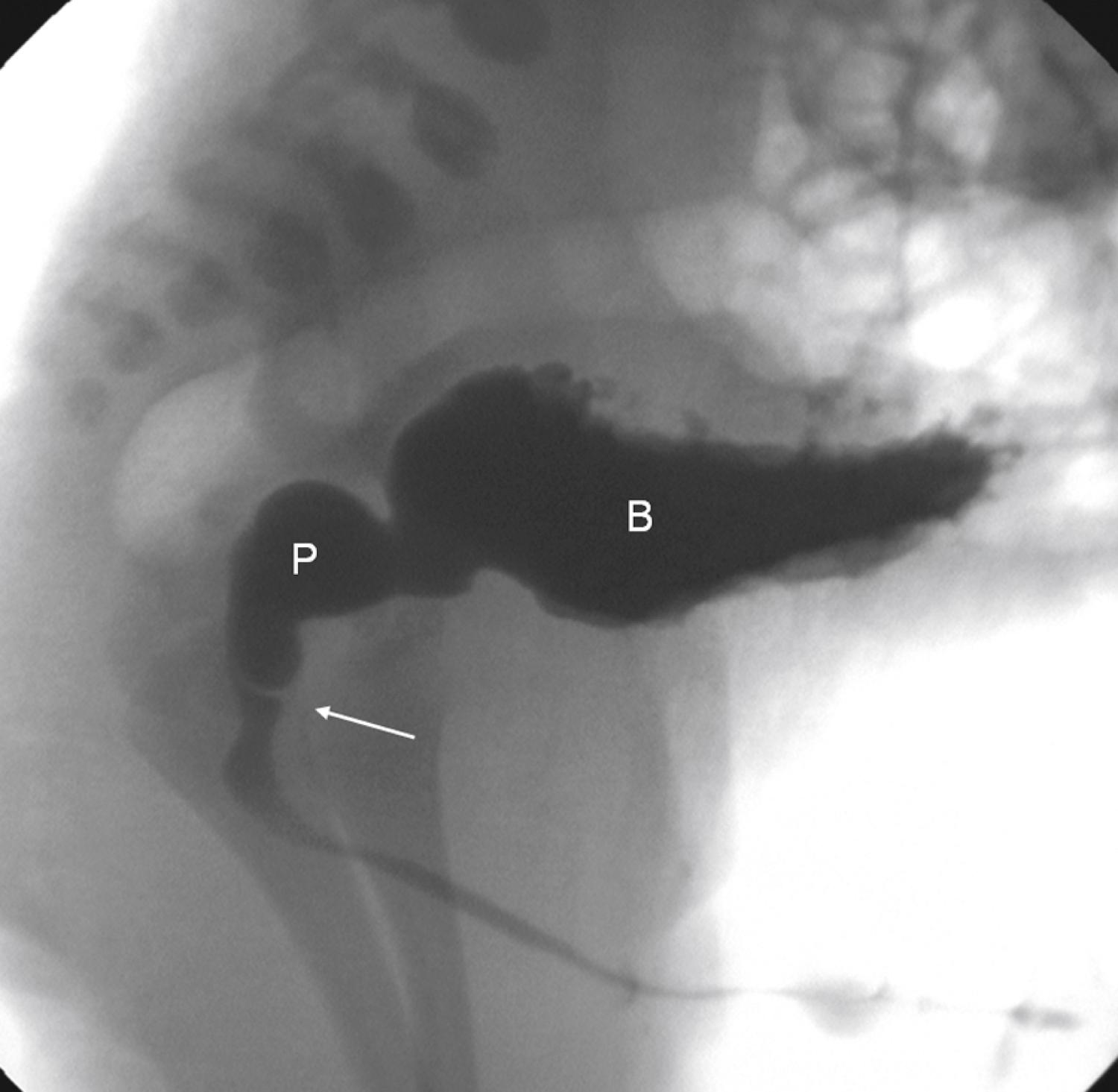
In patients with neurogenic bladder and myelomeningocele, voiding is usually impossible, and detecting reflux is the most important part of the study. In these cases, the bladder is filled to a volume appropriate for age or corresponding to typical volumes obtained during catheterization, with images obtained over the kidneys and ureters to evaluate for reflux. The bladder is then emptied through the catheter.
Become a Clinical Tree membership for Full access and enjoy Unlimited articles
If you are a member. Log in here